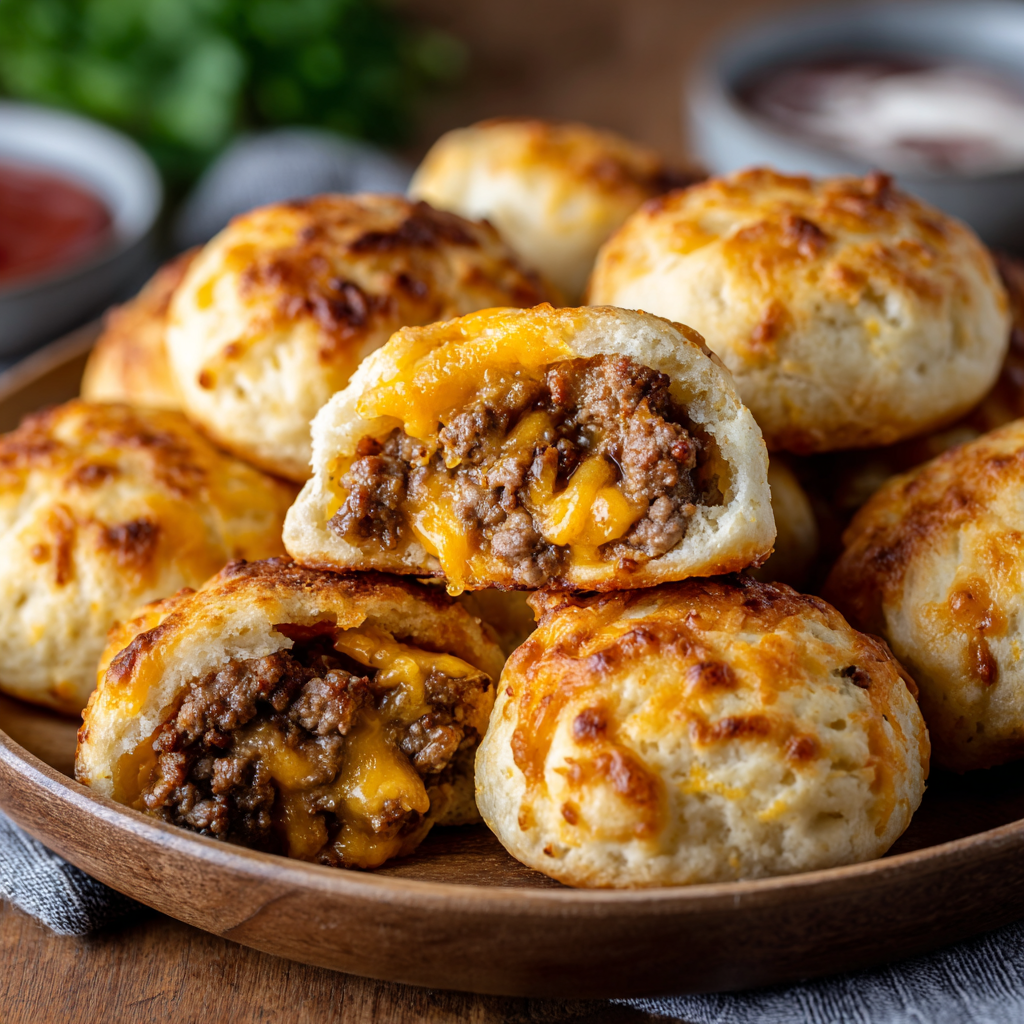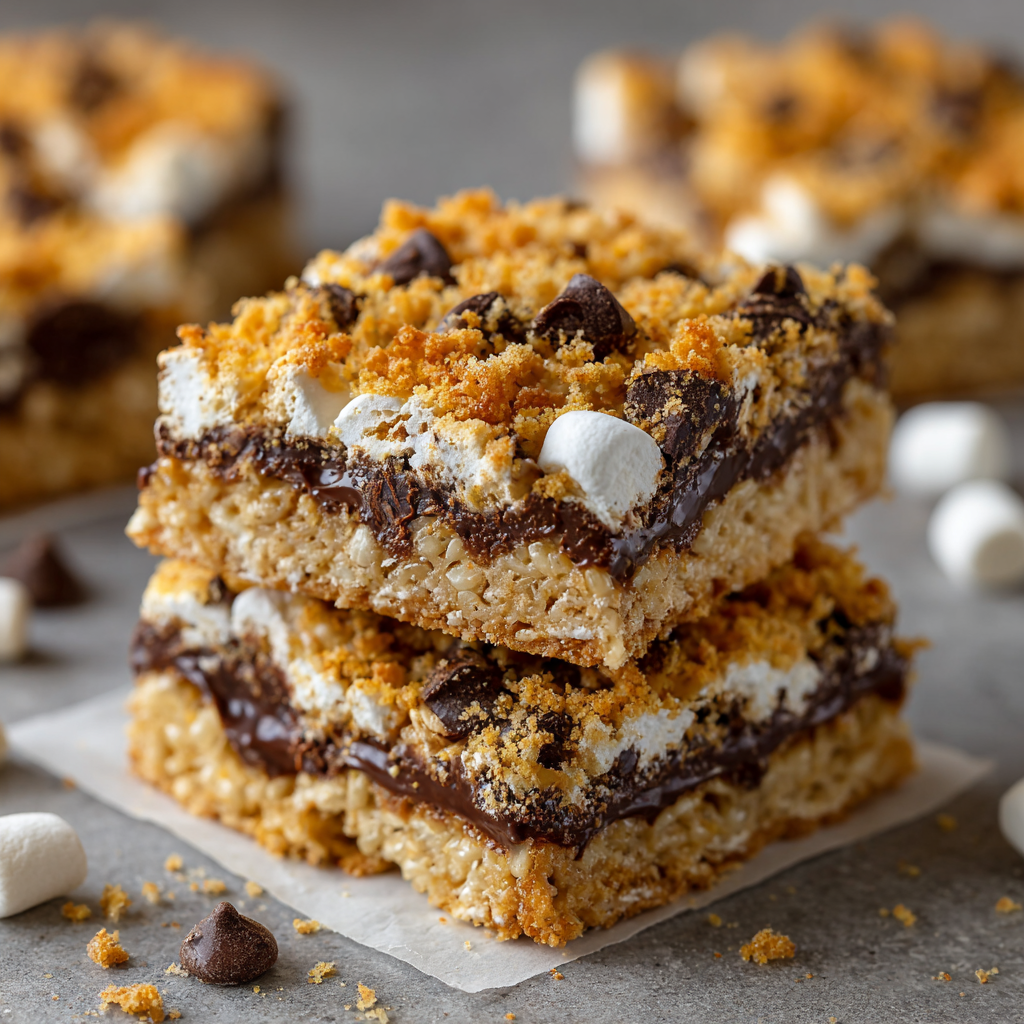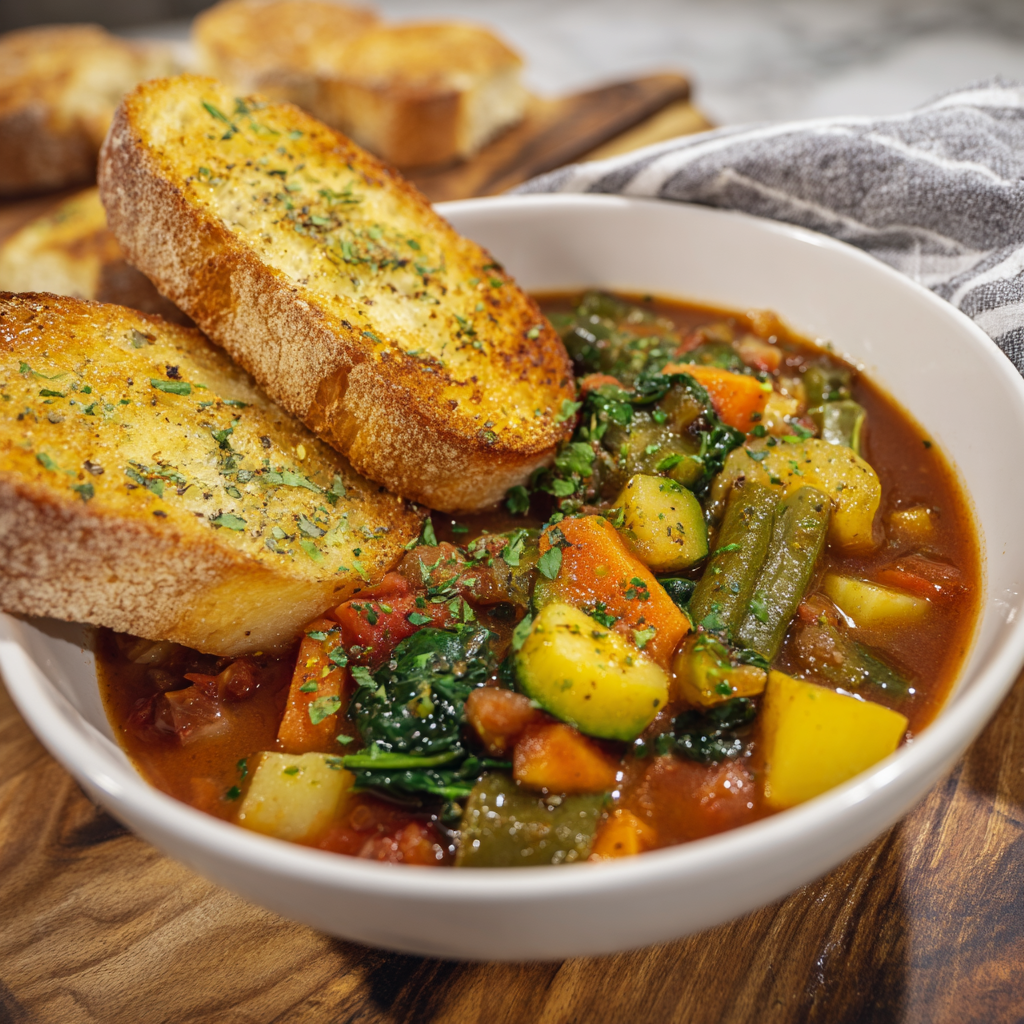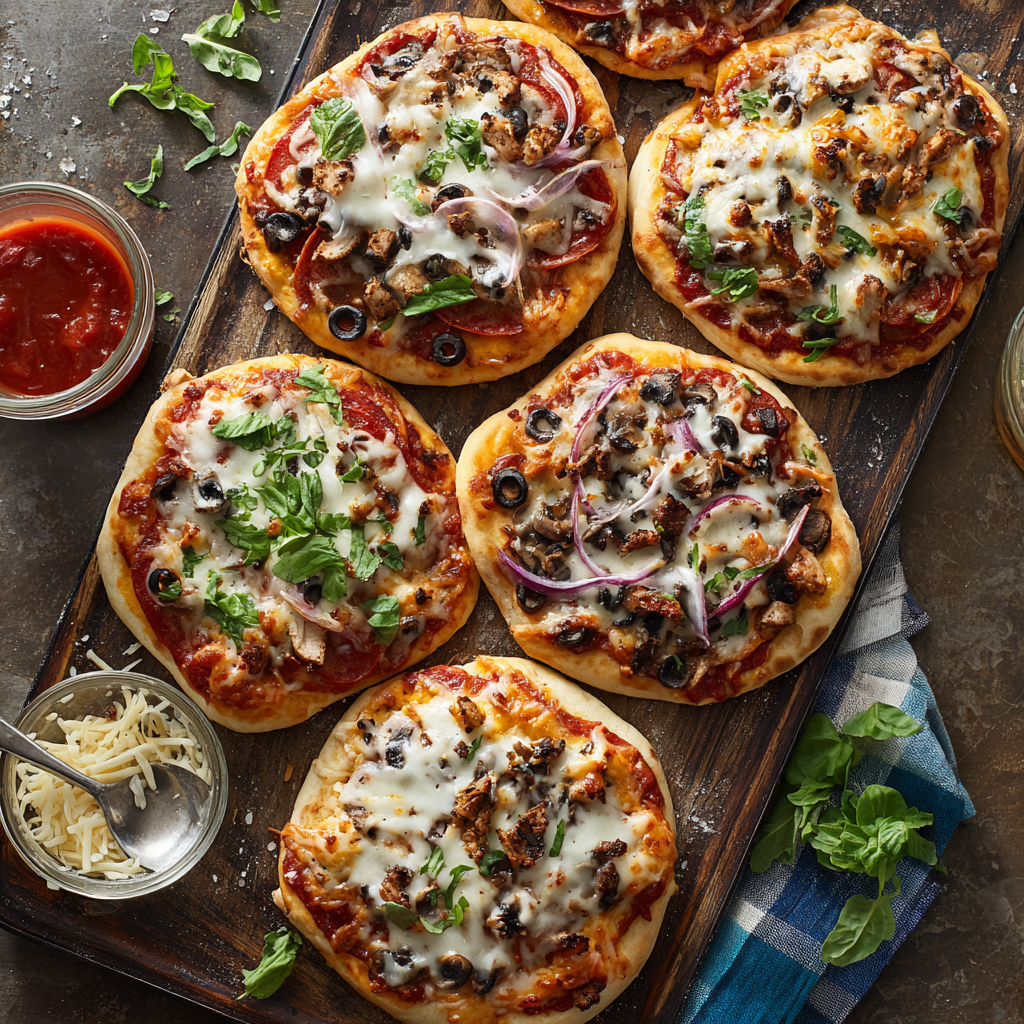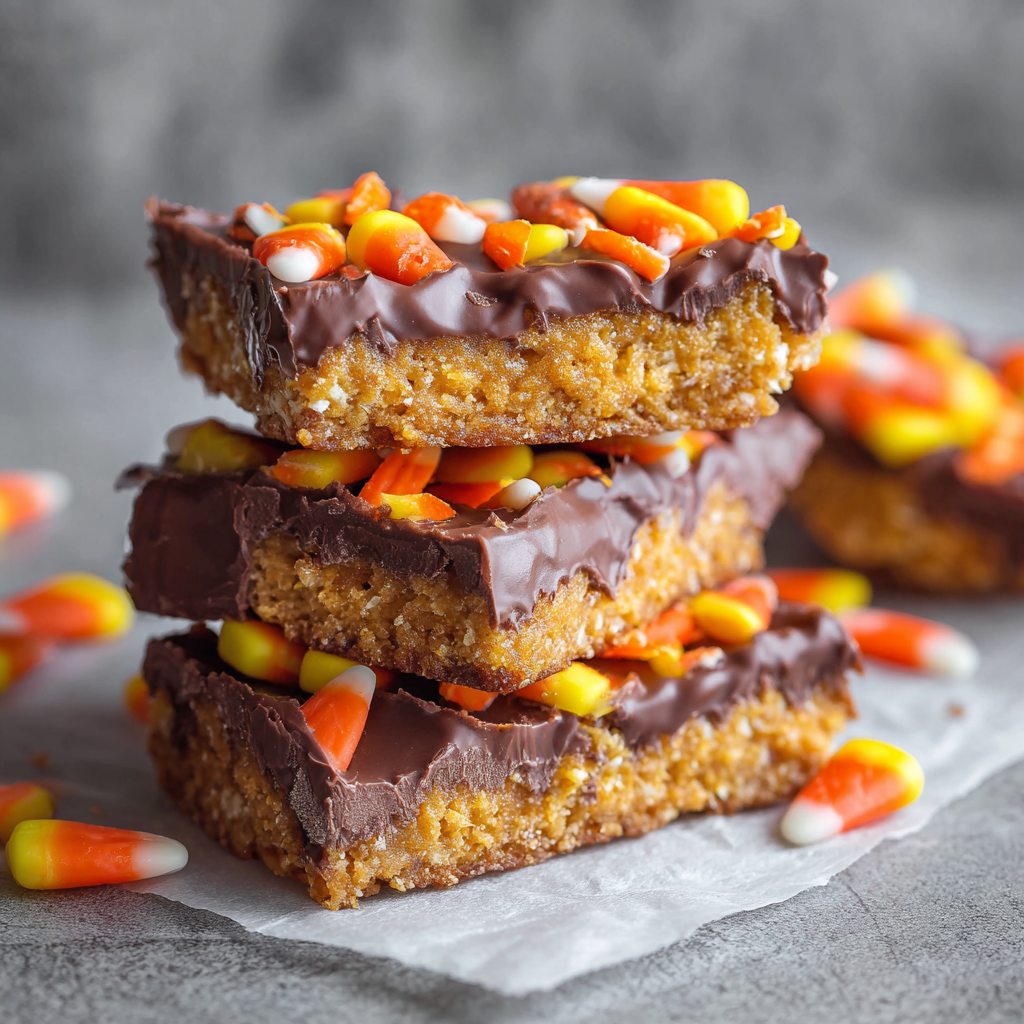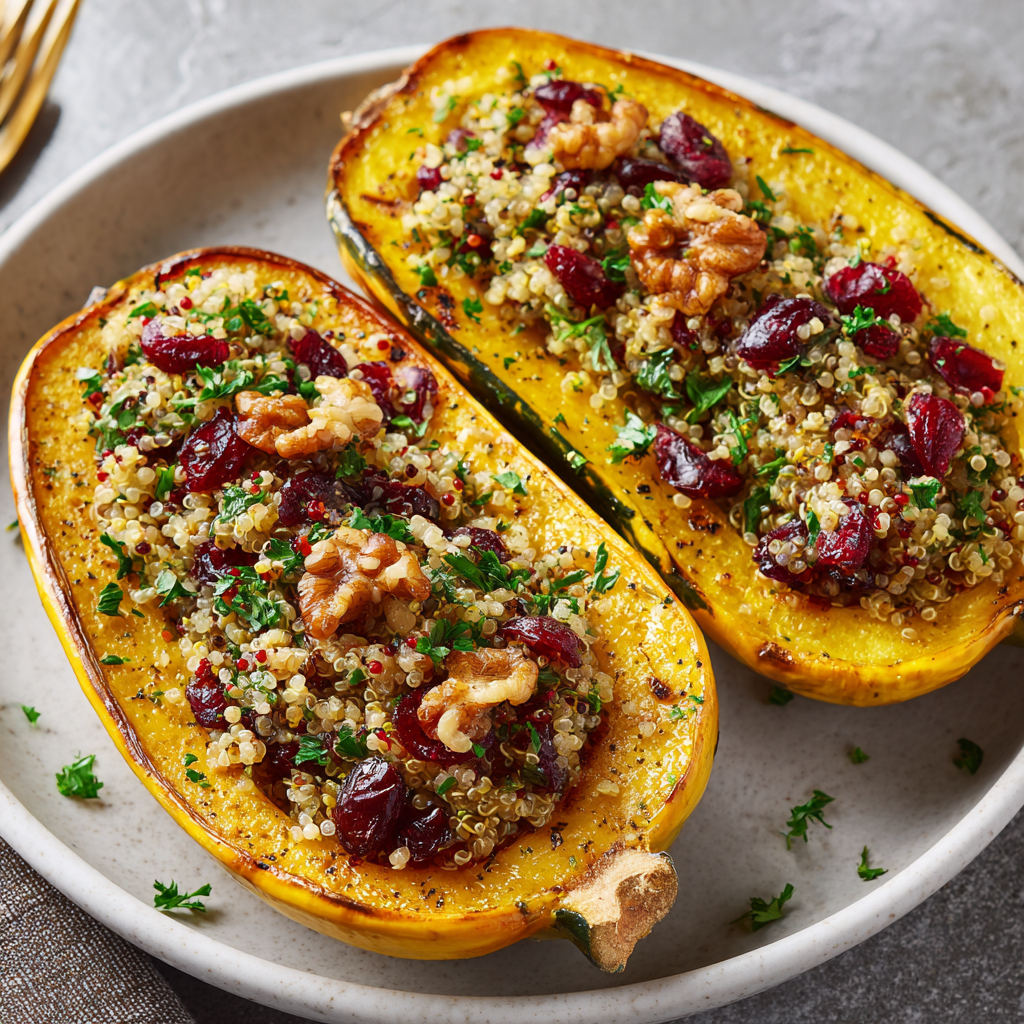
Stuffed Delicata Squash with Quinoa & Cranberries
Hey There, My Fellow Food Lover! Welcome to My Cozy Kitchen Corner.
Is there anything better than the smell of something utterly delicious roasting in the oven? That warm, toasty, slightly sweet aroma that just seems to hug the entire house? If you’re nodding along, then you and I are kindred spirits. I’m Olivia, and I truly believe that some of the best moments in life happen around the table, sharing food made with a whole lot of love. Today, we’re diving into a recipe that is the absolute epitome of cozy, vibrant, and downright satisfying food: Stuffed Delicata Squash with Quinoa & Cranberries.
This isn’t just another side dish. This is a showstopper. A meal that looks like you fussed for hours but is secretly one of the most forgiving, simple recipes in your arsenal. We’re taking tender, naturally sweet delicata squash—no pesky peeling required!—and turning it into an edible bowl for a fluffy, nutty, and tart quinoa filling. It’s a beautiful dance of textures and flavors that celebrates the best of the season. It’s vegetarian without trying to be, hearty without being heavy, and perfect for a quiet Tuesday night or as the stunning centerpiece of your holiday spread. So, tie on your favorite apron (the messy one with all the stains tells the best stories), and let’s make something unforgettable together.
A Squash, A Smile, and The Start of An Autumn Tradition
This recipe always takes me right back to my first fall in this house. The leaves were a fiery blaze, there was a definite chill in the air, and I was hosting my new neighbors for a casual dinner. I wanted to make something that felt special and seasonal but wouldn’t have me chained to the stove all day. I spotted these beautiful, striped delicata squash at the farmer’s market and just knew I had to work with them. Back in my kitchen, I improvised with what I had: some leftover quinoa, cranberries for a pop of color, and pecans for crunch.
As they roasted, the most incredible caramelized, sweet smell filled the kitchen. When I pulled them out, golden-brown and tender, I knew it was going to be good. But the real magic happened when we sat down to eat. That first bite—the creamy squash, the savory filling, the tart cranberries—elicited a chorus of “mmmms” around the table. It wasn’t just about the food; it was about the connection. That dish broke the ice, sparked laughter, and turned neighbors into friends. Now, every time I make it, I’m reminded that the best meals aren’t about perfection; they’re about the joy you share while eating them.
Gathering Your A-Team: The Ingredients
Here’s your shopping list! This is where the flavor magic begins. I’ve added my little chef-y notes and swaps so you can make this dish your own.
- 2 delicata squash: The star of the show! Look for firm squash with vibrant yellow skin and green stripes, and no soft spots. The best part? The skin is tender and completely edible after roasting, saving you a major prep step. Chef’s Insight: Can’t find delicata? Acorn squash is a great substitute; just add 10-15 minutes to the roasting time.
- 1 tablespoon olive oil: For coating the squash and helping it get beautifully caramelized and tender.
- Salt and pepper to taste: The essential flavor boosters. Don’t be shy!
- 1 cup cooked quinoa: I use tri-color quinoa for extra visual flair, but any color works. Pro Tip: For the fluffiest quinoa, rinse it thoroughly in a fine-mesh strainer before cooking to remove its natural bitter coating (saponin). Cook it in vegetable broth instead of water for a major flavor upgrade.
- ¼ cup dried cranberries: They provide little bursts of tart sweetness that cut through the richness perfectly. Substitution Tip: Chopped dried apricots or cherries would be fantastic here too!
- ¼ cup chopped toasted pecans or walnuts: Toasting is non-negotiable! It unlocks their deep, nutty flavor and adds a crucial crunchy texture. Allergy-Friendly Swap: Sunflower seeds or pepitas are a wonderful nut-free alternative.
- 2 tablespoons chopped fresh parsley: This isn’t just a garnish! The fresh, green flavor brightens up the entire dish. Flat-leaf parsley has the best flavor for cooking.
- 1 tablespoon olive oil: For the dressing. A good, fruity extra-virgin olive oil will make a difference.
- 1 tablespoon lemon juice: The acid is key! It balances the sweetness of the squash and cranberries and makes all the flavors pop. Freshly squeezed is always best.
- ½ teaspoon ground cinnamon or allspice (optional): A warm, cozy spice that whispers “autumn.” It complements the squash’s natural flavor beautifully. If you’re not sure, start with a ¼ teaspoon.
- Salt and pepper to taste: Yes, again! Season your filling just as well as you season your squash.
Let’s Get Cooking: Your Foolproof Steps to Deliciousness
Ready? Let’s turn these beautiful ingredients into a masterpiece. Follow these steps, and you really can’t go wrong.
Step 1: Preheat and Prep. Fire up your oven to 400°F (200°C). This is the perfect roasting temperature—hot enough to caramelize the squash’s sugars but not so hot that it burns before cooking through. While it heats, tackle the squash. Give them a good scrub under running water since we’re eating the skin. Slice them in half lengthwise—a sharp chef’s knife makes this easy. Then, use a sturdy spoon to scoop out the seeds and stringy pulp. Don’t toss those seeds! You can rinse them, toss with a little oil and salt, and roast them on a separate pan for a tasty snack.
Step 2: Roast to Perfection. Place your four squash halves on a baking sheet (line it with parchment paper for super easy cleanup). Drizzle or brush the cut sides with that tablespoon of olive oil, making sure they’re fully coated. This is what gives us that gorgeous, crispy-edged, tender result. Now, be generous with the salt and pepper! Season them like you mean it. Here’s my biggest hack for this step: place them cut-side down on the baking sheet. This creates a steamy environment inside the squash boat, ensuring the flesh gets incredibly tender and creamy. Roast for 25-30 minutes. You’ll know they’re done when you can easily pierce the flesh with a fork.
Step 3: Create the Filling. While the squash is working its magic in the oven, let’s make the filling. In a medium bowl, combine your fluffy cooked quinoa, tart dried cranberries, and those all-important toasted, chopped nuts. Add in the fresh parsley. In a small bowl or a measuring cup, whisk together the tablespoon of olive oil, tablespoon of lemon juice, and your optional pinch of warm spice. Pour this simple dressing over the quinoa mixture and toss everything together until it’s happily combined. Now, taste it! This is the most important step. Does it need more salt? A bit more lemon zing? Adjust it until it sings. Remember, this filling will be nestled inside the sweet squash, so you want it to be flavorful and vibrant on its own.
Step 4: Stuff and Warm Through. Once the squash halves are tender, carefully remove the pan from the oven. They will be hot, so use oven mitts! Flip them over so the cut side is facing up—they are now your beautiful, edible bowls. Divide the quinoa filling evenly among the four halves, piling it high because more is more. Gently press it down so it stays put. Pop the stuffed squash back into the oven for just 5-10 more minutes. This final bake allows the flavors to meld together and everything to get perfectly warm and cozy.
Plating with Pizzazz: How to Serve Your Masterpiece
Presentation is part of the fun! Let these stuffed squash shine. I love to serve each person their own half—it feels so special. Slide a spatula under each one to transfer it to a plate without the filling tumbling out. For a gorgeous finishing touch, drizzle a tiny bit of high-quality olive oil over the top and scatter a few extra chopped herbs or nuts. A little sprinkle of flaky sea salt right at the end is *chef’s kiss*. They are a complete meal on their own, but if you’re serving them as a side, they pair beautifully with a simple roast chicken or pork tenderloin. For a vegan feast, serve alongside some crispy roasted Brussels sprouts.
Make It Your Own: Delicious Variations
The fun doesn’t stop here! This recipe is a fantastic template for creativity.
- Thanksgiving Twist: Add ¼ cup of cooked, crumbled sage-infused sausage (plant-based or pork) to the filling for a heartier holiday side.
- Mediterranean Magic: Swap the cranberries for chopped sun-dried tomatoes and Kalamata olives. Use basil instead of parsley and add a handful of crumbled feta cheese (add after the final bake so it doesn’t melt).
- Apple & Sage: Sauté one small diced apple and a tablespoon of fresh chopped sage before adding it to the quinoa mixture. It’s autumn in a bowl!
- Creamy & Dreamy: Stir 2-3 tablespoons of goat cheese or cream cheese into the warm quinoa filling for an extra rich and creamy texture.
- Protein Power-Up: Add a can of rinsed and drained chickpeas or lentils to the filling to boost the protein and make it even more substantial.
Olivia’s Chef Notes & Kitchen Stories
This recipe has evolved so much since that first nervous dinner party! I’ve learned a few things along the way. First, the “cut-side down” roasting method was a total game-changer I discovered after a few batches of slightly underdone squash. Trust the process! Second, I am a firm believer in toasting your nuts. I once was in a huge rush and skipped it, and the whole dish felt… flat. That extra five minutes is worth it, I promise.
This is also my go-to “fridge clean-out” recipe. Got some leftover farro or wild rice? Use it instead of quinoa. Have some wilting spinach? Chop it up and stir it into the filling—it will wilt perfectly in the final bake. The goal is to feel confident and creative, not constrained. Cooking should be fun, a little messy, and always, always done with love.
Your Questions, Answered!
Q: My squash is still pretty firm after 30 minutes. What did I do wrong?
A: Don’t worry! Oven temperatures can vary, and squash sizes can differ. The most likely culprit is that your squash halves were particularly large or thick. Just flip them cut-side up, cover the pan loosely with foil to prevent burning, and roast for another 10-15 minutes until perfectly fork-tender.
Q: Can I make this ahead of time for a dinner party?
A: Absolutely! You can roast the squash halves and prepare the filling separately up to 24 hours in advance. Store them in airtight containers in the fridge. When you’re ready to serve, let the squash come to room temperature for 20 minutes, stuff them, and then bake for 15-20 minutes (since they’ll be starting from cold) until heated through.
Q: My quinoa filling turned out a bit dry. How can I fix it?
A> This usually happens if the quinoa was a tad overcooked or not quite enough dressing was used. Next time, make sure your quinoa is still slightly moist after cooking. For now, simply drizzle a tablespoon or two of vegetable broth or a little more olive oil and lemon juice over the filling before the final bake. This will add back that needed moisture.
Q: Is delicata squash skin really edible?
A> Yes, 100%! That’s one of its greatest perks. Once roasted, the skin becomes tender, thin, and completely delicious. No peeling required—just give it a good wash.
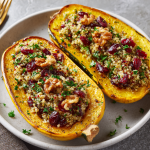
Stuffed Delicata Squash with Quinoa & Cranberries
Description
Today, we’re making Stuffed Delicata Squash with Quinoa & Cranberries—a cozy, colorful, and nutrient-packed dish. Tender, naturally sweet delicata squash becomes an edible bowl for a fluffy, nutty, tart quinoa filling. It’s vegetarian, hearty, and perfect for a quiet weeknight dinner or as the centerpiece of your holiday table.
Ingredients
-
2 delicata squash (or substitute with acorn squash, add 10–15 mins to roasting time)
-
1 tablespoon olive oil (for squash)
-
Salt and pepper, to taste
-
1 cup cooked quinoa (tri-color quinoa adds visual flair)
-
¼ cup dried cranberries (substitute: chopped dried apricots or cherries)
-
¼ cup chopped toasted pecans or walnuts (nut-free option: sunflower seeds or pepitas)
-
2 tablespoons chopped fresh parsley
-
1 tablespoon olive oil (for dressing)
-
1 tablespoon lemon juice (freshly squeezed is best)
-
½ teaspoon ground cinnamon or allspice (optional, start with ¼ tsp if unsure)
-
Salt and pepper, to taste
Instructions
Step 1: Preheat & Prep
-
Preheat oven to 400°F (200°C).
-
Scrub the squash and slice lengthwise. Scoop out seeds and stringy pulp (roast seeds separately if desired).
Step 2: Roast Squash
-
Place squash halves cut-side down on a parchment-lined baking sheet.
-
Drizzle with 1 tablespoon olive oil and season with salt and pepper.
-
Roast for 25-30 minutes, until fork-tender.
Tip: Cut-side down creates a steamy environment for creamy, tender squash.
Step 3: Make the Filling
-
In a bowl, combine cooked quinoa, cranberries, toasted nuts, and parsley.
-
In a small bowl, whisk 1 tbsp olive oil, 1 tbsp lemon juice, and optional spice.
-
Pour over quinoa mixture and toss. Taste and adjust seasoning.
Tip: Dressing should be flavorful; it balances the natural sweetness of the squash and cranberries.
Step 4: Stuff & Finish
-
Flip roasted squash cut-side up.
-
Divide quinoa filling among the halves, pressing gently to secure.
-
Return to oven for 5-10 minutes to warm through and meld flavors.
Step 5: Serve
-
Drizzle extra olive oil over the top, sprinkle with parsley or nuts, and add flaky sea salt if desired.
-
Serve as a complete meal or as a side with roast chicken, pork tenderloin, or roasted Brussels sprouts.
Notes
-
Thanksgiving Twist: Add ¼ cup crumbled sage-infused sausage to the filling.
-
Mediterranean Magic: Swap cranberries for sun-dried tomatoes & Kalamata olives, parsley for basil, and finish with feta.
-
Apple & Sage: Sauté diced apple with fresh sage and fold into quinoa.
-
Creamy Variation: Stir in 2-3 tablespoons goat cheese or cream cheese.
-
Protein Boost: Add chickpeas or lentils to make it heartier.
Nutrition
- Calories: 230cal Per Serving
- Sodium: 90mg
- Fat: 10g
- Saturated Fat: 1g
- Carbohydrates: 30g
Nutritional Information (Per Serving)
This is an approximate calculation and can vary based on specific ingredients used.
Calories: 230 | Fat: 10g | Saturated Fat: 1g | Cholesterol: 0mg | Sodium: 90mg | Carbohydrates: 30g | Sugars: 6g | Fiber: 5g | Protein: 5g
Final Thoughts
And just like that, we’ve taken a few simple, wholesome ingredients and transformed them into something truly extraordinary. This Stuffed Delicata Squash is more than a recipe; it’s a testament to the beauty of simple, seasonal cooking. It’s a lesson in embracing natural packaging, in building textures and flavors with intention, and in finding the perfect balance between sweet and savory on a single plate.
I hope this guide has inspired you to see the potential in a humble squash and a bag of grains. I hope it’s given you the confidence to toast your nuts, to season fearlessly, and to never, ever underestimate the power of a squeeze of fresh lemon juice. Most of all, I hope it encourages you to gather people around your table, to share food made with love, and to create your own stories and traditions. This dish, with its warm, welcoming flavors, is the perfect place to start. Thank you for cooking with me today. Now, go enjoy the fruits (or squashes!) of your labor. You’ve earned it.
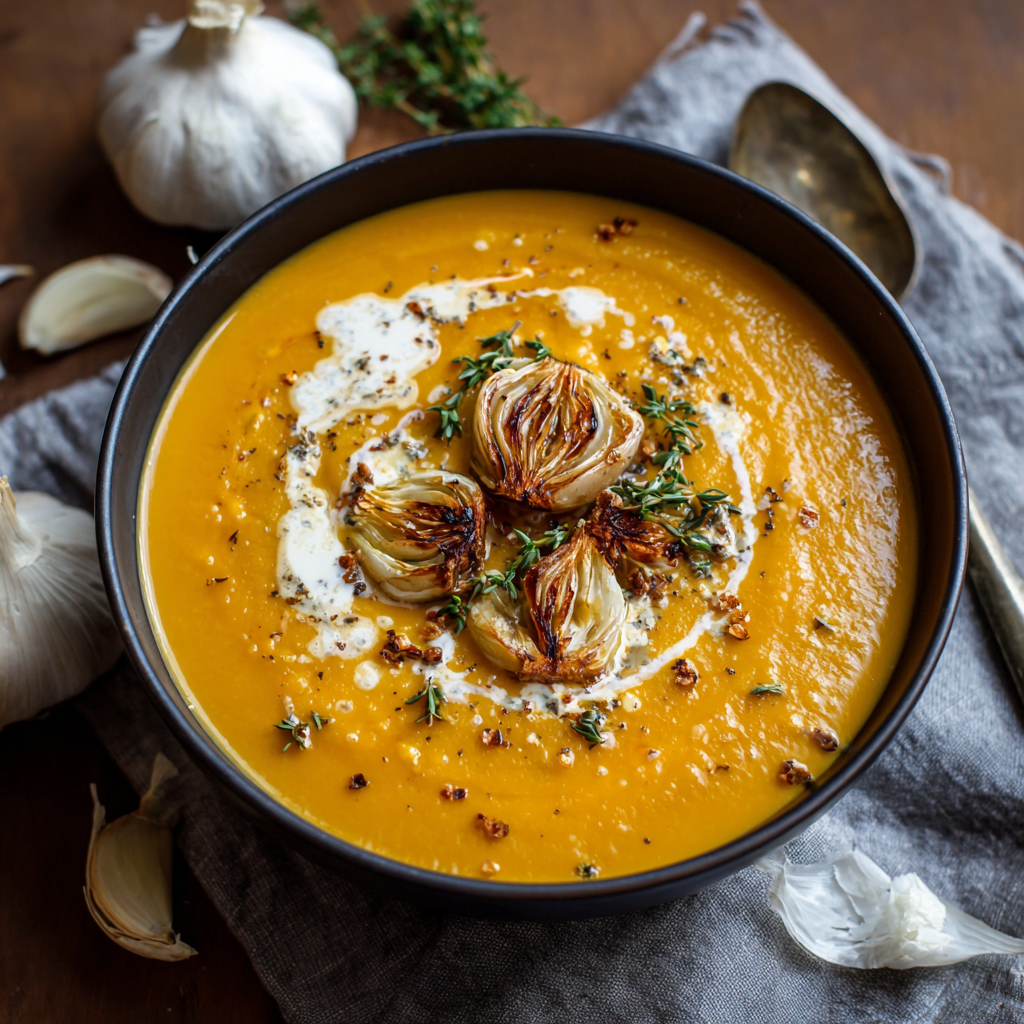
Roasted Garlic & Sweet Potato Bisque
Cozy Up With a Bowl of Pure Comfort
Hey there, friend! Can you smell that? It’s the unmistakable, heart-warming aroma of sweet potatoes and garlic caramelizing in the oven, a scent that just wraps you up like your favorite worn-in sweater. There’s a crispness in the air, the leaves are putting on their final fiery show, and all my soul craves is a big, steaming bowl of something deeply comforting. And let me tell you, this Roasted Garlic & Sweet Potato Bisque is the answer to all those cozy cravings.
This isn’t just any soup. This is a velvety, rich, and soul-soothing bisque that tastes like it simmered for hours, but secretly comes together with surprisingly little effort. We’re taking humble, beautiful ingredients and transforming them into something truly luxurious. The natural, candy-like sweetness of the roasted sweet potatoes pairs magically with the deep, mellow, almost nutty flavor of roasted garlic. It’s a hug in a bowl, I promise you.
Whether you’re meal-prepping for the week, need a show-stopping starter for your next dinner party, or just want to treat yourself to a nourishing lunch, this recipe is your new best friend. So, grab your favorite apron (the messy one with all the stories), and let’s make something unforgettable together.
The Soup That Started It All
This bisque recipe holds a seriously special place in my heart. It takes me right back to my first tiny apartment, with a kitchen so small you could practically touch all four walls at once. I was fresh out of college, on a tight budget, and desperately trying to impress my new boyfriend (now husband!) with my “culinary skills,” which at that point mostly involved expertly boiling pasta.
He was coming over for a fall-themed dinner date, and I was determined to make something that felt fancy and autumnal without breaking the bank. I had a bag of sweet potatoes, a head of garlic, and a whole lot of hope. The moment I pulled that roasting pan out of the oven, the entire apartment filled with this incredible, sweet-and-savory perfume. When I blended it all together and took that first tentative taste? I actually did a little happy dance right there in my galley kitchen. It was creamy, complex, and felt infinitely more sophisticated than the sum of its parts. His face when he tried it? Priceless. He still requests it every year when the weather turns. It’s our little edible tradition, a delicious reminder that the best meals aren’t about fancy techniques—they’re about heart.
Gathering Your Cozy Ingredients
Here’s the beautiful part: this gourmet-tasting bisque is made with incredibly simple, wholesome ingredients. Each one plays a key role in building that deep, layered flavor.
- 2 large sweet potatoes, peeled and cubed – Look for firm potatoes with smooth, unblemished skin. The orange-fleshed varieties (like Beauregard or Garnet) are the sweetest and will give you that gorgeous sunset color. Chef’s Insight: Cubing them ensures they roast evenly and get those delicious caramelized edges!
- 1 whole head of garlic – Don’t be shy! Roasting transforms garlic from pungent and sharp to sweet, buttery, and spreadable. It’s the secret weapon here.
- 1 tablespoon olive oil – For roasting. Its fruity notes work perfectly. Avocado oil is a great high-heat substitute.
- 1 medium onion, chopped – A yellow or white onion is perfect for building a sweet, savory base flavor.
- 1 tablespoon butter – This adds a layer of rich, comforting flavor as we sauté our onions. For a dairy-free version, just use more olive oil.
- 4 cups vegetable or chicken broth – This is the foundation of your soup, so use a good-quality broth you enjoy! I use low-sodium so I can control the salt level myself. Substitution Tip: Either works beautifully. Veggie broth keeps it plant-based, while chicken broth adds a touch more savory depth.
- 1 teaspoon thyme (fresh or dried) – Thyme and sweet potato are a match made in heaven. It adds that essential earthy, autumn herb note. If using fresh, you’ll need a bit more—about a tablespoon of fresh leaves.
- ½ teaspoon ground cumin – This is my little flavor hack! Cumin adds a warm, slightly smoky depth that complements the sweetness without overpowering it. Trust me on this one.
- ½ cup heavy cream or coconut milk (optional) – For that luxurious, “bisque” texture. The cream makes it ultra-rich and silky. For a dairy-free or lighter option, full-fat canned coconut milk is absolutely divine and adds a subtle tropical note that works surprisingly well.
- Salt and freshly cracked black pepper to taste – Essential for making all those flavors pop! I always use coarse sea salt and grind my pepper fresh.
Let’s Make Some Magic: Step-by-Step
Okay, apron on! Let’s transform these simple ingredients into a bowl of golden goodness. Read through all the steps first—it’s a simple process, but my commentary and hacks will make it foolproof.
Step 1: Preheat and Prep
Preheat your oven to 400°F (200°C). This is the perfect roasting temperature to caramelize the potatoes and mellow the garlic. While it heats, peel and cube your sweet potatoes into roughly 1-inch chunks. Try to make them uniform so they cook at the same rate. Chef’s Hack: If your potatoes are particularly sticky, give your hands a very light coat of oil before handling them—it makes cleanup so much easier!
Step 2: Roast to Perfection
Take your whole head of garlic and slice about ¼ to ½ inch off the top to expose the cloves. Place it on a small piece of foil, drizzle the exposed cloves with a little of the olive oil, and wrap it up into a little packet. Toss your sweet potato cubes with the remaining olive oil on a baking sheet, and place the foil-wrapped garlic packet right on the sheet with them. Roast for 30-35 minutes, giving the potatoes a stir halfway through. You’ll know they’re done when they’re tender enough to easily pierce with a fork and have some beautiful browned spots.
Step 3: Build the Base
While the roasting magic happens, let’s start the soup base. In a large pot or Dutch oven, melt your tablespoon of butter over medium heat. Add the chopped onion and sauté for 5-7 minutes, until it becomes soft and translucent. You’re not looking for color here, just sweetness. This step builds a foundational flavor layer that raw onion just can’t provide.
Step 4: Squeeze and Simmer
By now, your kitchen should smell amazing. Carefully remove the garlic packet—it will be hot! Once it’s cool enough to handle, squeeze the bottom of the head and all those soft, fragrant, roasted garlic cloves will just pop right out into the pot. It’s the most satisfying thing! Add the roasted sweet potatoes, thyme, cumin, and your broth. Bring it all to a lively simmer and let it bubble away for about 10 minutes. This allows all the flavors to get to know each other and mingle beautifully.
Step 5: Blend Until Dreamy
This is the transformative step! If you have an immersion blender, this is its time to shine. Carefully submerge it into the pot and blend until the soup is completely smooth and velvety. No immersion blender? No problem! Let the soup cool slightly, then blend it in batches in a regular countertop blender. CRUCIAL SAFETY TIP: If using a countertop blender, never fill it more than halfway with hot liquid, and hold the lid down firmly with a kitchen towel. The steam can build up pressure and blow the lid off—we want soup in the bowl, not on the ceiling!
Step 6: The Finishing Touches
Return the smooth soup to the pot if you used a blender. Now, stir in the heavy cream or coconut milk if you’re using it. This is where it goes from soup to luxurious bisque. Let it warm through over low heat for just a few minutes—don’t let it boil after adding cream. Finally, the most important step: season with salt and pepper to taste. Taste, adjust, taste again. You’ll be amazed how the right amount of salt makes every single flavor sing.
How to Serve This Sunshine in a Bowl
Ladle that gorgeous, vibrant orange bisque into deep bowls. Now, let’s make it pretty! A drizzle of cream or coconut milk swirled on top with the back of a spoon looks incredibly elegant. A sprinkle of fresh thyme leaves, a few crunchy roasted pepitas (pumpkin seeds), a crack of black pepper, or even a few homemade croutons for texture all make wonderful garnishes. Serve it immediately with a thick slice of crusty, buttered bread for dipping. Honestly, it’s a meal all on its own.
Make It Your Own: Delicious Variations
The beauty of this recipe is its flexibility! Here are a few of my favorite ways to switch it up:
- Spicy Kick: Add a pinch of cayenne pepper or chipotle powder with the cumin for a warm, smoky heat.
- Apple Twist: Add one peeled, chopped apple (like Granny Smith or Honeycrisp) to the roasting pan. Its tartness is a fantastic contrast to the sweetness.
- Thai-Inspired: Swap the thyme and cumin for 1 tbsp of red or green curry paste when sautéing the onions. Use coconut milk and garnish with cilantro and a squeeze of lime.
- Superfood Boost: Stir in a handful of fresh baby spinach or kale right after blending. The residual heat will wilt it perfectly, adding nutrients and color.
- Protein Power: For a heartier meal, top with shredded rotisserie chicken, crispy chickpeas, or even some seared scallops for a truly fancy twist.
From My Kitchen to Yours: Chef’s Notes
This recipe has evolved so much since that first apartment kitchen attempt! I’ve learned a few things along the way. First, don’t skip roasting the garlic. I tried it once with raw garlic sautéed with the onions and it was… aggressively garlicky and completely missing the mellow magic. Roasting is non-negotiable!
Secondly, I’ve become a huge advocate for the immersion blender. It’s one of my top three “can’t-live-without” kitchen tools for soups and sauces. It saves you from washing a blender and from potential hot soup explosions. Worth every penny!
Finally, this soup is arguably even better the next day. The flavors have more time to meld and deepen. It keeps beautifully in the fridge for up to 4 days and freezes wonderfully (just leave out the cream if you plan to freeze it, and add it when you reheat). It’s my ultimate make-ahead comfort food.
Your Questions, Answered!
Q: My soup turned out a bit too thick. How can I thin it out?
A: No worries, this is an easy fix! Simply whisk in a little more broth, water, or even some extra cream until it reaches your perfect, spoon-coating consistency. Remember, you can always add more liquid, but you can’t take it out, so add a splash at a time.
Q: Can I make this bisque completely vegan?
A: Absolutely, and it’s delicious! Use olive oil instead of butter for sautéing, ensure your broth is vegetable-based, and use full-fat canned coconut milk instead of heavy cream. The coconut milk adds a fantastic richness.
Q: I don’t have an immersion blender and I’m nervous about using my regular blender. Any tips?
A> Your caution is wise! The key is to let the soup cool significantly before blending—at least 15-20 minutes. Never fill the blender jar more than halfway. Hold the lid on securely with a kitchen towel (not just your hand), and start on the lowest possible speed, gradually increasing it. You can also remove the center cap from the lid and cover the hole with the towel to allow steam to escape safely.
Q: The soup tastes a little flat. What did I do wrong?
A: It’s almost always a seasoning issue! “Flat” usually means it needs more salt. Salt is a flavor enhancer. Add a little at a time, stirring and tasting after each addition. If it’s salted enough but still missing something, a tiny splash of acid can work wonders—try a squeeze of fresh lemon juice or a dash of apple cider vinegar to brighten all the flavors.
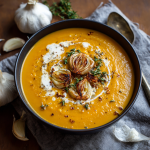
Roasted Garlic & Sweet Potato Bisque
- Total Time: 55 mins
Description
There’s something magical about the way sweet potatoes and roasted garlic come together—rich, velvety, and oh-so-cozy. This bisque is more than just soup; it’s comfort in a bowl, perfect for chilly nights, dinner parties, or a nourishing weekday meal. With its deep roasted flavors and silky smooth texture, it feels gourmet while staying wonderfully simple. Let’s turn these humble ingredients into pure golden bliss.
Ingredients
-
2 large sweet potatoes, peeled & cubed
-
1 whole head of garlic
-
1 tbsp olive oil
-
1 medium onion, chopped
-
1 tbsp butter (or olive oil for dairy-free)
-
4 cups vegetable or chicken broth
-
1 tsp thyme (fresh or dried)
-
½ tsp ground cumin
-
½ cup heavy cream or coconut milk (optional for creaminess)
-
Salt & freshly cracked black pepper, to taste
Instructions
-
Roast – Preheat oven to 400°F (200°C). Toss sweet potato cubes with olive oil on a baking sheet. Slice the top off the garlic head, drizzle with oil, wrap in foil, and roast alongside the potatoes for 30–35 min until tender and caramelized.
-
Sauté – In a large pot, melt butter. Add onion and cook 5–7 min until soft and translucent.
-
Combine – Squeeze roasted garlic cloves into the pot. Add roasted sweet potatoes, thyme, cumin, and broth. Simmer 10 min.
-
Blend – Use an immersion blender (or carefully blend in batches) until silky smooth.
-
Finish – Stir in cream or coconut milk if using. Season generously with salt and pepper. Warm through gently—don’t boil after adding cream.
-
Serve – Ladle into bowls, swirl with cream, sprinkle fresh thyme, pepitas, or croutons for garnish. Enjoy with crusty bread.
- Prep Time: 10 min
- Cook Time: 45 mins
Nutrition
- Calories: 180cal Per Serving
- Fat: 7g
- Cholesterol: 10mg
Nutritional Information*
Per Serving (Approximate, without optional cream):
Calories: 180 | Fat: 7g | Saturated Fat: 3g | Cholesterol: 10mg | Sodium: 480mg | Carbohydrates: 28g | Fiber: 4g | Sugar: 9g | Protein: 3g
*Please note: Nutritional information is a rough estimate and can vary greatly based on the specific ingredients and brands you use. Values calculated without the optional heavy cream.
Prep Time: 15 minutes | Cook Time: 45 minutes | Total Time: 1 hour | Servings: 4
Final Thoughts
This Roasted Garlic & Sweet Potato Bisque is so much more than the sum of its simple parts. It is a lesson in patience, demonstrating how the transformative power of roasting can unlock profound depths of flavor from the most humble ingredients. It is a practice in mindfulness, from the careful sautéing of onions to the patient blending into velvety smoothness. And most importantly, it is a vehicle for connection—a warm, golden, generously shared offering that nourishes the body and soothes the soul.
I hope this recipe becomes a cornerstone in your kitchen as it has in mine. I hope it’s there for you on a busy Sunday for meal prep, on a chilly weeknight for a quick dinner, and on a day when you or someone you love needs a tangible reminder of care and comfort. It’s a testament to the idea that the most satisfying food doesn’t require complexity, just intention and a little bit of culinary alchemy. Thank you for letting me share this cozy corner of my kitchen with you. Now, go forth, roast some garlic, and fill your home with the incomparable scent of autumn comfort.
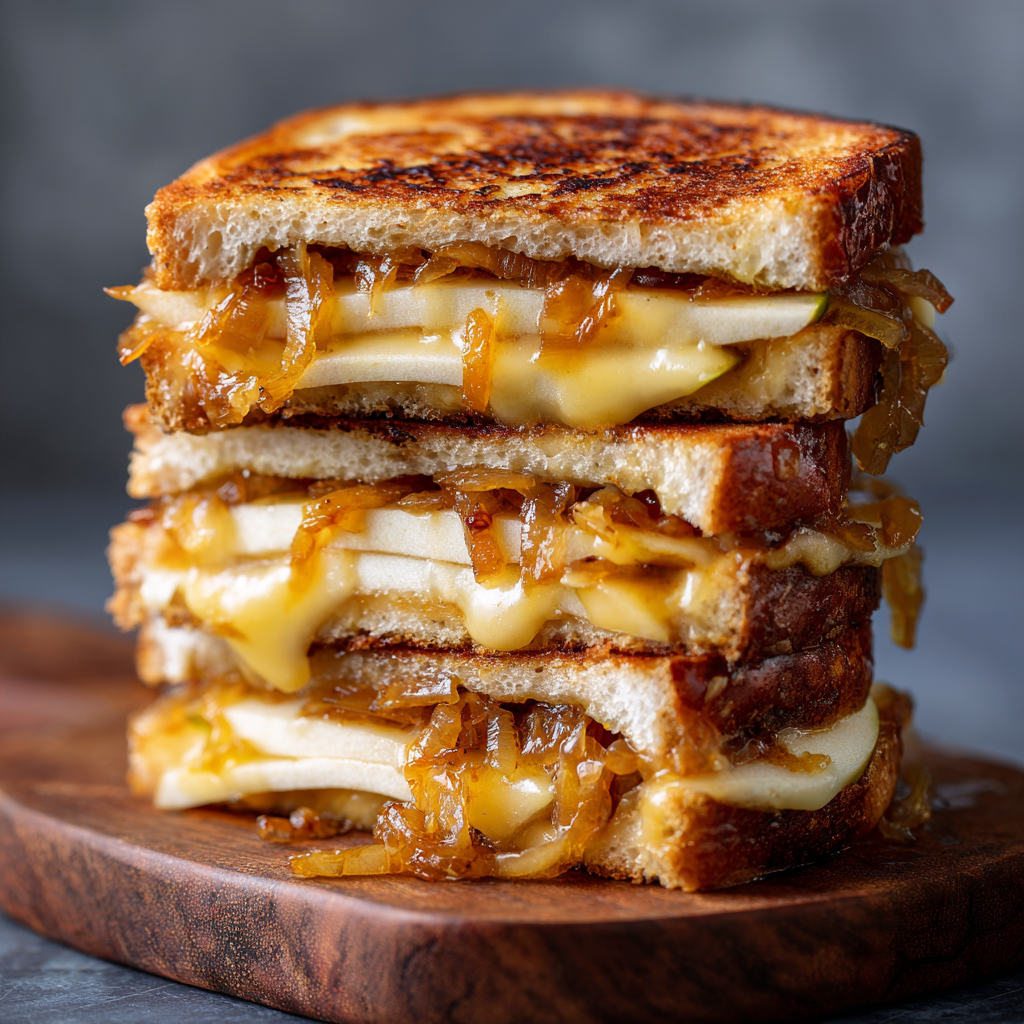
Apple & Cheddar Grilled Cheese with Caramelized Onions
Apple Cheddar Grilled Cheese: The Ultimate Cozy Upgrade
Hey there, friend! Come on in, pull up a stool. Can you smell that? It’s the unmistakable, soul-warming scent of onions slowly caramelizing in butter, mingling with the toasty aroma of bread browning in a skillet. It’s the kind of smell that makes everyone in the house drift into the kitchen, eyes wide with curiosity and stomachs rumbling. If you’re like me, you believe that a perfectly made grilled cheese is a love language all its own. But what if I told you we could take that classic, beloved comfort food and turn it into something truly spectacular?
Today, we’re making my absolute favorite sandwich: an Apple & Cheddar Grilled Cheese with sweet, jammy Caramelized Onions. This isn’t just a sandwich; it’s an experience. It’s the perfect harmony of flavors and textures—sharp, melty cheese, crisp and slightly sweet apple slices, deeply savory onions, all hugged by two slices of glorious, golden-brown, butter-toasted bread. It’s cozy enough for a rainy day but sophisticated enough to serve with a glass of wine. It’s the sandwich that will make you feel like a culinary genius with minimal effort. So, grab your favorite skillet and let’s make some magic together!
A Slice of Nostalgia & A Pinch of Curiosity
This sandwich has a fun little origin story in my kitchen. It all started a few years ago during a particularly crisp fall afternoon. My husband and I had just gone apple picking and returned home with a comical surplus of fruit. We had apple pies, apple crisps, and applesauce coming out of our ears. I was staring at this mountain of Honeycrisps, wondering what else I could possibly make, when I remembered a classic flavor pairing: apples and sharp cheddar. It’s a combo I’ve loved since I was a kid at my grandma’s house, where she’d always serve apple pie with a slice of cheese on the side.
I thought, “Why not put it *inside* the grilled cheese?” And then, because I firmly believe caramelized onions make everything better, I tossed those in too. The result was nothing short of a revelation. That first bite was a warm, gooey, sweet-and-savory masterpiece. It instantly became a staple in our house, a recipe I’ve tweaked and perfected and shared with countless friends. It’s more than a recipe; it’s a happy little accident born from a bounty of apples and a love for cozy food. It reminds me that the best dishes often come from a place of playful experimentation.
Gathering Your Cozy Ingredients
Here’s everything you’ll need to create this masterpiece. Don’t stress about exact brands—this is about using what you love and have on hand!
- 4 slices sourdough or rustic bread: The foundation! I love sourdough for its tangy flavor and sturdy structure, which holds up to the fillings without getting soggy. A good country loaf or even a hearty whole wheat works beautifully too.
- 2 tablespoons butter, softened: Softened is the key word here! It allows for an even, thin layer that toasts the bread to a perfect golden brown without burning. Salted or unsalted both work fine.
- 1 cup sharp white cheddar, shredded or sliced: The star of the show! Sharp cheddar has the bold flavor needed to stand up to the sweet apples and onions. I prefer white cheddar for its classic look, but orange is just as tasty. Chef’s Tip: Grating your own cheese from a block melts far better than pre-shredded cheese, which contains anti-caking agents.
- ½ apple, thinly sliced: I adore Honeycrisp for their sweet-tart balance and firm texture that doesn’t turn to mush. Granny Smith is a fantastic tangy alternative. Just be sure to slice them thinly so they soften slightly in the heat.
- ½ cup caramelized onions: The secret weapon! They add a deep, sweet, umami richness. See below for how to make them. Pro move: Caramelize a big batch ahead of time and keep them in the fridge for easy sandwich, pizza, or burger upgrades all week!
For the Caramelized Onions:
- 1 large yellow onion, thinly sliced: Yellow onions are perfect here—they have the right sugar content for caramelizing.
- 1 tablespoon butter or olive oil: Butter adds incredible flavor, but olive oil works great too.
- A big pinch of salt: This helps draw the moisture out of the onions, speeding up the process.
Let’s Build the Ultimate Grilled Cheese!
Okay, apron on! Let’s do this step-by-step. Remember, low and slow is the motto for the best results.
- Caramelize Your Onions (if you haven’t already): This is the step that requires the most patience, but I promise it’s worth it. In a skillet over low heat, melt your tablespoon of butter. Add the thinly sliced onions and a pinch of salt. Cook, stirring occasionally, for 25-30 minutes. Don’t rush this by turning up the heat! You want them to become a deep golden brown, soft, and sweet. If they start to stick, add a tiny splash of water. Set them aside when done.
- Prep Your Sandwich Station: While the onions are working their magic, get everything else ready. Thinly slice your apple. Grate or slice your cheese. Soften your butter. This mise en place (fancy chef talk for “everything in its place”) makes assembly a breeze.
- Butter the Bread: Spread a thin, even layer of softened butter on one side of each slice of bread. This will become the gorgeous, crispy exterior of your sandwich.
- Build the Sandwich: Place two slices of bread, buttered side down, on your cutting board. On the unbuttered side, start layering: first, a generous layer of cheese. This creates a “glue” that helps hold everything together. Next, a single layer of apple slices, followed by a hearty spoonful of those glorious caramelized onions. Top it all off with another layer of cheese—this is crucial for sealing the deal! Place the remaining slices of bread on top, buttered side out.
- Grill to Perfection: Heat a skillet or griddle over medium-low heat. Yes, medium-low! We want the heat to gently penetrate the sandwich and melt all that cheese without burning the beautiful, buttery crust. Place your sandwiches in the skillet. Cook for 3-4 minutes, until the bottom is a deep golden brown. Chef’s Hack: Press down gently with a spatula now and then for even contact. Carefully flip and cook the other side for another 3-4 minutes, until equally golden and the cheese is visibly oozy and melted.
- The Final Test: If you press lightly on the top of the sandwich with your spatula and see a gentle, cheesy squish, you know it’s ready. If the bread is browning too quickly before the cheese melts, just turn the heat down a smidge.
How to Serve Your Masterpiece
Okay, the moment of truth! Immediately transfer your gorgeous grilled cheese to a cutting board and let it rest for just a minute—this allows the cheese to set slightly so it doesn’t all squirt out on the first bite. Slice it in half diagonally (because it just tastes better that way, right?). I love serving this sandwich on a simple wooden board or a colorful plate. It’s rich and satisfying all on its own, but it’s incredible with a side of tomato soup for dipping, a simple green salad with a bright vinaigrette to cut through the richness, or even a handful of crispy potato chips for that perfect crunch contrast.
Make It Your Own: Delicious Variations
The beauty of this recipe is its versatility! Here are a few ways to switch it up:
- Add a Protein: Crumble in some cooked bacon or sliced ham for a heartier, saltier kick.
- Spice It Up: Add a layer of whole grain mustard or a drizzle of hot honey on the inside of the bread before assembling for a sweet and spicy twist.
- Go Gourmet: Swap the cheddar for Gruyère or Fontina cheese for an even more complex, nutty flavor.
- Herbaceous Twist: Add a few fresh thyme leaves or a sprinkle of chopped rosemary in with the onions for an aromatic note.
- Gluten-Free/Dairy-Free: Use your favorite gluten-free bread and a good melting vegan cheese (and vegan butter). The apples and onions will still provide tons of flavor!
Chef Olivia’s Notebook
This recipe has truly evolved in my kitchen. The first time I made it, I was so impatient that I cranked the heat to high for the onions. Let’s just say I ended up with slightly burnt, still-crunchy onions and a smoky kitchen—not my finest hour! I learned that low and slow is non-negotiable for true caramelization. Now, I often caramelize a huge batch of onions on a lazy Sunday afternoon while I’m puttering around the kitchen listening to music. It’s become a therapeutic ritual. I’ve also learned that the type of apple really does matter. I once tried it with a Red Delicious (in a moment of desperation) and it turned to complete applesauce inside the sandwich. Stick with the firmer varieties for the best texture! This sandwich is a reminder that sometimes the simplest ideas, executed with a little care and patience, are the ones that become lifelong favorites.
Your Questions, Answered!
Q: My cheese isn’t melting by the time my bread is burning! What did I do wrong?
A: Ah, the classic grilled cheese dilemma! The heat is almost certainly too high. Grilled cheese is a lesson in patience. You want to cook it over medium-low heat to give the heat time to travel through the bread and gently melt the cheese without scorching the exterior. If this happens, just lower the heat and maybe even tent the skillet with a lid for a minute to trap heat and help the cheese along.
Q: Can I make this ahead of time?
A: You can prep the components ahead of time! Caramelize the onions and store them in the fridge for up to 5 days. Slice your cheese and apples (to prevent browning, toss the apple slices in a tiny bit of lemon juice). But for the best texture, assemble and cook the sandwiches just before serving.
Q: My sandwich is too soggy. How can I prevent that?
A: Sogginess usually comes from two things: 1) The onions weren’t cooked long enough and still have too much moisture, or 2) The apple slices were too thick. Ensure your onions are deeply caramelized and have no liquid left in the pan, and slice your apples paper-thin so they just warm through without releasing much water.
Q: What’s the best way to slice the sandwich without squishing it?
A: Use a sharp chef’s knife and a gentle sawing motion. Don’t press down with all your weight! Let the sharp blade do the work. Some people even swear by using dental floss (unflavored, obviously!) to slice through gooey grilled cheese cleanly.

Apple & Cheddar Grilled Cheese with Caramelized Onions
- Total Time: 45 minutes (mostly hands-off for onions)
Description
This grilled cheese is the ultimate cozy upgrade. It combines sharp, melty cheddar, crisp sweet apple, and deeply savory caramelized onions between two slices of perfectly golden, buttery bread. It’s a simple sandwich that feels incredibly gourmet.
Ingredients
-
4 slices sourdough or rustic bread
-
2 tbsp butter, softened
-
1 cup sharp white cheddar cheese, shredded
-
½ a firm apple (Honeycrisp or Granny Smith), thinly sliced
-
For Caramelized Onions:
-
1 large yellow onion, thinly sliced
-
1 tbsp butter or olive oil
-
A big pinch of salt
-
Instructions
1. Caramelize the Onions:
* This step requires patience but is worth it! In a skillet over low heat, melt 1 tbsp of butter. Add the sliced onions and salt.
* Cook for 25-30 minutes, stirring occasionally, until the onions are deeply golden brown, soft, and sweet. If they stick, add a tiny splash of water. Set aside.
2. Prep Your Ingredients:
* While onions cook, thinly slice the apple and shred the cheese. Soften the 2 tbsp of butter for spreading.
3. Build the Sandwiches:
* Spread a thin layer of softened butter on one side of each bread slice.
* Place two slices, buttered-side down. Layer on each: half the cheese, the apple slices, a generous spoonful of caramelized onions, and the remaining cheese.
* Top with the remaining bread slices, buttered-side up.
4. Cook to Perfection:
* Heat a clean skillet or griddle over medium-low heat.
* Place the sandwiches in the pan. Cook for 3-4 minutes per side, pressing down gently with a spatula, until the bread is golden brown and the cheese is fully melted.
* Tip: If the bread is browning too fast before the cheese melts, reduce the heat.
5. Serve:
* Let the sandwich rest for 1 minute before slicing diagonally. Serve immediately.
Notes
-
Low and Slow is Key: Don’t rush the onions or the grilling process. Low heat for both ensures sweet, jammy onions and a perfectly melted interior without burnt bread.
-
Grate Your Own Cheese: Cheese grated from a block melts much smoother and creamier than pre-shredded cheese.
-
Make-Ahead: Caramelize a big batch of onions ahead of time and store them in the fridge for up to 5 days for quick sandwich assembly.
-
Prevent Soggy Bread: Ensure your caramelized onions are cooked until all their moisture has evaporated, and slice your apples very thinly.
- Prep Time: 10 minutes (plus onion time)
- Cook Time: 10 minutes
Nutrition
- Calories: 460 cal Per Sandwich
- Sodium: 550mg
- Fat: 27g
- Saturated Fat: 15g
- Fiber: 3g
Nutritional Information*
Per Sandwich:
Calories: ~460 | Fat: 27g | Saturated Fat: 15g | Cholesterol: 70mg | Sodium: 550mg | Carbohydrates: 38g | Fiber: 3g | Sugars: 8g | Protein: 14g
Final Thoughts: The Comfort of a Classic, Perfected
The humble grilled cheese sandwich is a universal comfort food for a reason. It’s simple, satisfying, and deeply nostalgic. This Apple Cheddar version doesn’t seek to replace that classic; it seeks to elevate it into something that feels both special and familiar. It takes a beloved formula and introduces layers of complexity—sweetness, depth, texture, and sophistication—without ever losing its soul.
This recipe is a celebration of patience (with those onions), quality (in the cheese and bread), and balance (in every bite). It proves that with a little extra care and attention to technique, a weeknight staple can be transformed into a culinary event. It’s a sandwich that feels right at home on a weeknight dinner table alongside a bowl of soup, but it’s also impressive enough to serve to guests at a casual autumn gathering. It’s a reminder that the best cooking often isn’t about following a recipe to the letter, but about understanding principles: low heat for melting, contrast for texture, and the timeless power of a perfect flavor pairing. So here’s to the grilled cheese—a simple pleasure, made extraordinary.
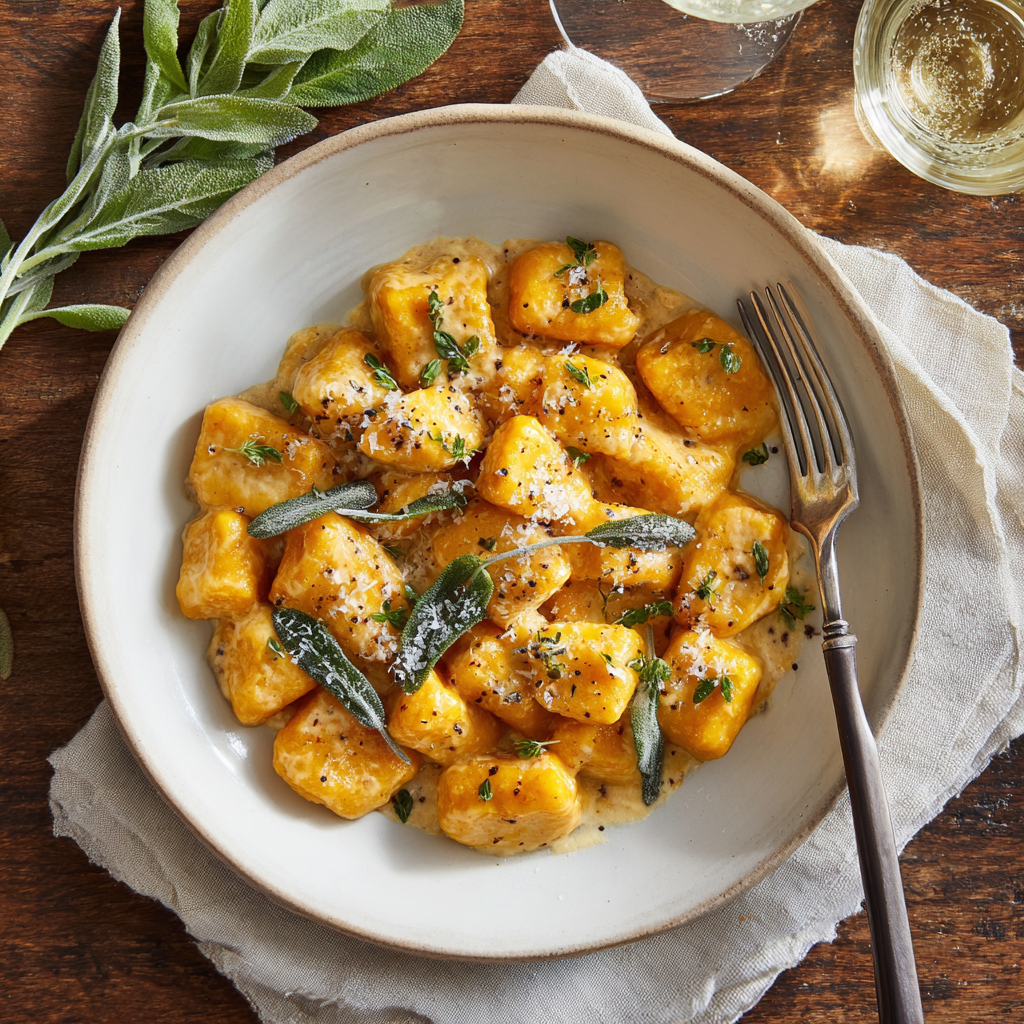
Pumpkin Gnocchi with Sage Cream Sauce
Welcome, Fall! Let’s Make Pumpkin Gnocchi with Sage Cream Sauce
Hey there, friend! Come on in, the kitchen’s warm, I’ve got a latte brewing, and there’s a unmistakable scent of roasting pumpkin and sage in the air. If your heart does a little happy dance at the first sign of crisp autumn air and the sight of gourds piled high at the market, you are absolutely in the right place today. We’re not just making dinner; we’re crafting a hug in a bowl. We’re turning simple, beautiful ingredients into a dish that tastes like a golden-hour glow feels—warm, soft, and utterly magical.
I’m talking about my all-time favorite fall comfort food: Pumpkin Gnocchi with a Silky Sage Cream Sauce. Now, I see you! Don’t you dare get nervous. The word “gnocchi” can sound intimidating, like something only nonnas and professional chefs can master. But I’m here to let you in on a little secret: this version is shockingly simple. We’re using a brilliant little shortcut (hello, ricotta!) that guarantees light, pillowy dumplings every single time, no fancy potato-ricer required. Tossed in a luxurious sauce that comes together in minutes, this dish is the perfect project for a lazy Sunday and elegant enough to be the star of your next dinner party. So, tie on your favorite apron, and let’s make some cozy magic together.
The Pumpkin Patch Promise
This recipe always takes me right back to my favorite kind of autumn afternoon. A few years ago, my best friend and I took our kids to the pumpkin patch. It was one of those perfect, sunny days where the light is pure gold and everyone is wearing just the right amount of flannel. The kids were racing through the corn maze, we were sipping hot cider, and we ended up buying way, way more sugar pumpkins than any sane person could possibly need. “We’ll make pies!” we declared, with ambitious, cider-fueled enthusiasm.
Of course, reality set in later that week with a mountain of roasted pumpkin purée staring me down from the fridge. A pie (or three) was made, but I wanted to create something savory, something that captured that fun, earthy, joyful feeling of the patch itself. I started playing—mixing pumpkin with ricotta, a little parm, a whisper of nutmeg. The first batch of gnocchi I boiled and tossed with this brown butter sage sauce was a revelation. It was the taste of that perfect day, of laughter, of crisp leaves, and of a promise to always find magic in the season. It’s been a fall tradition ever since.
Gathering Your Cozy Ingredients
Here’s your shopping list! The beauty of this recipe is in its simplicity, so using the best-quality ingredients you can find really makes a difference. Let’s break it down.
For the Pumpkin Gnocchi:
- 1 cup pumpkin purée: Please, please use canned pure pumpkin purée or make your own by roasting a sugar pumpkin. Do NOT use pumpkin pie filling, which is pre-sweetened and spiced. Your gnocchi will be very confused and very sweet! If you’re in a pinch, butternut squash purée works beautifully too.
- 1 cup ricotta cheese, drained: Full-fat is best for flavor and texture here. The key step is draining it! Pop it in a fine-mesh strainer over a bowl for 20-30 minutes to get rid of excess water. This is our secret weapon for light gnocchi without the fuss of potatoes.
- ½ cup grated Parmesan: Freshly grated from a block is a million times better than the pre-shredded stuff, which often contains anti-caking agents. It melts smoother and tastes infinitely more flavorful.
- 1 egg yolk: This acts as our binder, bringing the dough together beautifully. Save the white for a healthy scramble tomorrow morning!
- 1 teaspoon salt: Essential for waking up all those lovely flavors.
- ¼ teaspoon nutmeg: Just a hint! Nutmeg and pumpkin are a classic, cozy pairing. Freshly grated nutmeg is a game-changer if you have it.
- 1½ to 2 cups all-purpose flour: Start with 1½ cups. You’ll likely need a bit more, but we add it gradually. The goal is a soft, slightly sticky dough, not a dry one. The less flour we can get away with, the lighter the gnocchi!
For the Sage Cream Sauce:
- 2 tablespoons butter: Unsalted is my preference so I can control the salt level myself.
- 6–8 fresh sage leaves: Fresh is non-negotiable here. Dried sage just won’t give you that incredible, aromatic fragrance. You’ll gently fry these in the butter to create a flavor base that is out-of-this-world good.
- 1 cup heavy cream: This is what creates that dreamy, silky, luxurious sauce. For a lighter version, you could use half-and-half, but the sauce won’t be quite as rich or thick.
- ½ cup grated Parmesan: More cheesy goodness to thicken and flavor the sauce.
- Salt and pepper, to taste: Freshly cracked black pepper is a must for a little warmth.
Let’s Make Some Magic: Step-by-Step
Okay, hands-on time! This process is therapeutic, I promise. Put on some music, pour yourself a drink, and let’s get into a flow.
Step 1: The Dough
In a large bowl, combine the pumpkin purée, drained ricotta, grated Parmesan, egg yolk, salt, and nutmeg. Use a spatula to mix until it’s completely smooth and harmonious. Now, add 1 cup of the flour and stir until just combined. Add another ½ cup and mix again. It will be shaggy and sticky—that’s perfect!
Chef’s Hack: I always mix the initial flour in with a spatula to avoid overworking the dough. Once it starts to come together, I turn it out onto a very well-floured surface.
Step 2: Knead (Gently!)
Dump the shaggy dough onto a floured counter. Sprinkle a little more flour on top and gently knead it, incorporating just enough additional flour (a tablespoon at a time) until the dough is soft, smooth, and only slightly sticky to the touch. This should only take about 2-3 minutes. Do not over-knead! We’re not making bread. Overworking it develops gluten and leads to tough, chewy gnocchi.
Step 3: Shape the Gnocchi
Divide your beautiful dough into four equal parts. Keep the other pieces covered with a towel while you work with one. Using your hands, roll one piece into a long rope, about ½-inch thick. If it’s sticking, dust your hands and the surface with a tiny bit more flour. Use a sharp knife or a bench scraper to cut the rope into 1-inch pieces. These are your gnocchi! You can leave them as little pillows, or you can give them the classic ridged texture by rolling each one down the tines of a fork. This helps the sauce cling later. Place your finished gnocchi on a parchment-lined baking sheet dusted with flour or semolina to prevent sticking.
Step 4: Cook to Perfection
Bring a large pot of generously salted water to a vigorous boil. Gently drop in your gnocchi in batches—don’t overcrowd the pot! They will sink to the bottom. Within 2-3 minutes, they will float to the surface. Let them cook for one more minute once they’ve floated, then promptly scoop them out with a slotted spoon or spider strainer and transfer them directly to your waiting sauce. They cook fast!
Step 5: The Sage Cream Sauce
While your water is coming to a boil or your first batch of gnocchi is cooking, start the sauce. In a large skillet (big enough to hold all the gnocchi later), melt the butter over medium heat. Add the sage leaves and let them sizzle gently for about 1-2 minutes until fragrant and slightly crisp. You’re infusing the butter with their incredible flavor. Pour in the heavy cream, bring it to a gentle simmer, and let it cook for 2-3 minutes to thicken slightly. Reduce the heat to low and whisk in the grated Parmesan until it’s melted and smooth. Season with salt and a good crack of black pepper.
Step 6: The Grand Finale
As your cooked gnocchi come out of the water, add them directly to the simmering sauce. Gently toss them to coat every single pillowy nook and cranny in that creamy, sage-y goodness. Let them mingle in the pan for just a minute so the flavors marry.
How to Serve This Masterpiece
Presentation is part of the fun! I love serving this family-style in a big, warm, shallow bowl. Use a large spoon or tongs to create a beautiful mound of gnocchi. Drizzle any extra sauce from the pan over the top. Finish it with a final snow-like shower of freshly grated Parmesan, a few extra crispy fried sage leaves for garnish and texture, and another crack of black pepper. It’s a rich dish, so a simple side like a bitter arugula salad with a lemon vinaigrette is the perfect fresh contrast to cut through the creaminess.
Make It Your Own: Delicious Variations
The beauty of this recipe is its versatility! Here are a few ways to switch it up:
- Brown Butter Bliss: For a nuttier, slightly lighter sauce, skip the cream. Double the butter, fry the sage, and then simply toss the cooked gnocchi in the brown butter and sage. Finish with Parmesan.
- Protein Power-Up: Add some crispy pancetta or chopped bacon to the skillet before the butter. Render the fat out, remove the meat, and then use that flavorful fat to fry your sage.
- Vegan Twist: Use a vegan ricotta and pumpkin mix, a flax “egg” (1 tbsp ground flax + 3 tbsp water), and nutritional yeast instead of Parmesan. For the sauce, a cashew cream or full-fat coconut milk can work wonders.
- Sweet Potato Swap: Out of pumpkin? An equal amount of sweet potato purée is a fantastic and delicious substitute.
- Herb Garden: Add a teaspoon of fresh, chopped thyme or rosemary to the dough for an extra layer of earthy flavor.
Olivia’s Chef Notes & Kitchen Stories
This recipe has been through so many iterations in my kitchen! The first time I made it, I was so scared of sticky dough that I added nearly three cups of flour. We ended up with delicious little dumplings, but they were decidedly… dense. We still ate them, of course, but it was a valuable lesson in restraint. The dough *should* be a little tacky. Trust the process!
Another funny memory: I once tried to roll the entire batch of dough into one gigantic rope. It stretched across my entire kitchen island and snapped in the middle, sending flour everywhere. My dog thought it was a fantastic game. Now I always, always divide the dough. Lesson learned the messy way! The recipe has evolved to be foolproof, and that ricotta trick? I learned that from an Italian grandmother at a farmers’ market years ago, and it revolutionized my gnocchi game forever. It’s a recipe that feels like a collection of stories and tips from food lovers, and I’m so happy to finally be sharing it with you.
Your Gnocchi Questions, Answered!
Q: My dough is really sticky and I’m struggling to handle it. What do I do?
A: Don’t panic! This is common. First, make sure your work surface and your hands are very well-floured. Add flour a single tablespoon at a time, gently kneading it in, until the dough is just workable. Remember, a slightly sticky dough is better than a dry, tough one. You can also chill the dough for 20-30 minutes, which makes it much easier to handle.
Q: Why did my gnocchi fall apart in the water?
A: This usually means the dough needed a bit more flour or needed to be kneaded just a touch more to come together. It can also happen if your water is at a rolling boil—a vigorous boil can be too rough on delicate gnocchi. A strong simmer is perfect.
Q: Can I make these ahead of time?
A: Absolutely! You can shape the gnocchi and place them in a single layer on a flour-dusted baking sheet, then freeze them solid. Once frozen, transfer them to a zip-top bag. Cook them directly from frozen, adding a minute or two to the cooking time. This is a fantastic meal prep hack!
Q: My sauce looks a little thin. How can I thicken it?
A: Let it simmer for another minute or two to reduce. You can also add a little more grated Parmesan, which will help thicken it. If you’re really in a pinch, a tiny slurry of cornstarch and water (a teaspoon of each mixed) whisked in will do the trick, but I prefer the reduction method.
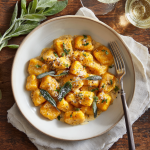
Pumpkin Gnocchi with Sage Cream Sauce
Description
Imagine pillowy-soft dumplings kissed with nutmeg, bathed in a velvety sage cream sauce. This dish is pure fall comfort—like wrapping yourself in a cozy blanket on a crisp evening. Light, golden, and fragrant, it’s perfect for a Sunday dinner or to impress at a festive gathering. Grab a latte, turn on some music, and let’s create your next autumn tradition.
Ingredients
Pumpkin Gnocchi
-
1 cup pumpkin purée (not pie filling)
-
1 cup ricotta cheese, drained
-
½ cup grated Parmesan
-
1 egg yolk
-
1 tsp salt
-
¼ tsp nutmeg
-
1½–2 cups all-purpose flour
Sage Cream Sauce
-
2 tbsp unsalted butter
-
6–8 fresh sage leaves
-
1 cup heavy cream
-
½ cup grated Parmesan
-
Salt & black pepper, to taste
Instructions
-
Make Dough – Mix pumpkin, ricotta, Parmesan, yolk, salt & nutmeg. Stir in 1½ cups flour until shaggy. Turn onto floured surface and knead gently, adding flour as needed until smooth but slightly tacky.
-
Shape Gnocchi – Divide dough into 4 parts. Roll each into ropes ½-inch thick. Cut into 1-inch pillows; press gently with a fork for ridges. Place on floured tray.
-
Cook Gnocchi – Boil salted water. Drop gnocchi in batches. When they float (2–3 mins), cook 1 more minute, then transfer to sauce.
-
Make Sauce – Melt butter in a skillet. Fry sage until crisp & fragrant. Stir in cream, simmer 2–3 mins. Whisk in Parmesan until smooth. Season.
-
Combine & Serve – Toss hot gnocchi in sauce. Garnish with extra Parmesan, cracked pepper, and crispy sage.
Notes
Chill dough 20 mins if sticky.
Freeze uncooked gnocchi on a tray, then bag for future quick meals.
For a lighter version, use brown butter + sage instead of cream.
Nutrition
- Calories: 430 cal Per Serving
- Sugar: 3g
- Fat: 25g
- Carbohydrates: 35g
- Fiber: 2g
- Protein: 15g
Nutritional Information*
Per Serving (Approximate):
Calories: 430 | Fat: 25g | Saturated Fat: 15g | Cholesterol: 110mg | Sodium: 520mg | Carbohydrates: 35g | Fiber: 2g | Sugars: 3g | Protein: 15g
Final Thoughts
This Pumpkin Gnocchi with Sage Cream Sauce is a celebration in a bowl. It’s a testament to the fact that the most satisfying meals often come from honoring simple, seasonal ingredients and treating them with care and respect. It demystifies a classic technique, proving that creating restaurant-quality comfort food at home is not only possible but deeply rewarding. From the science of achieving the perfect pillowy texture to the art of building a deeply flavorful sauce, this recipe is designed to empower you. It’s an invitation to embrace the rhythm of autumn, to slow down, and to find joy in the process of creating something beautiful and delicious from scratch. So, welcome the season, gather your ingredients, and create a warm, golden-hour glow of your own right in your kitchen.
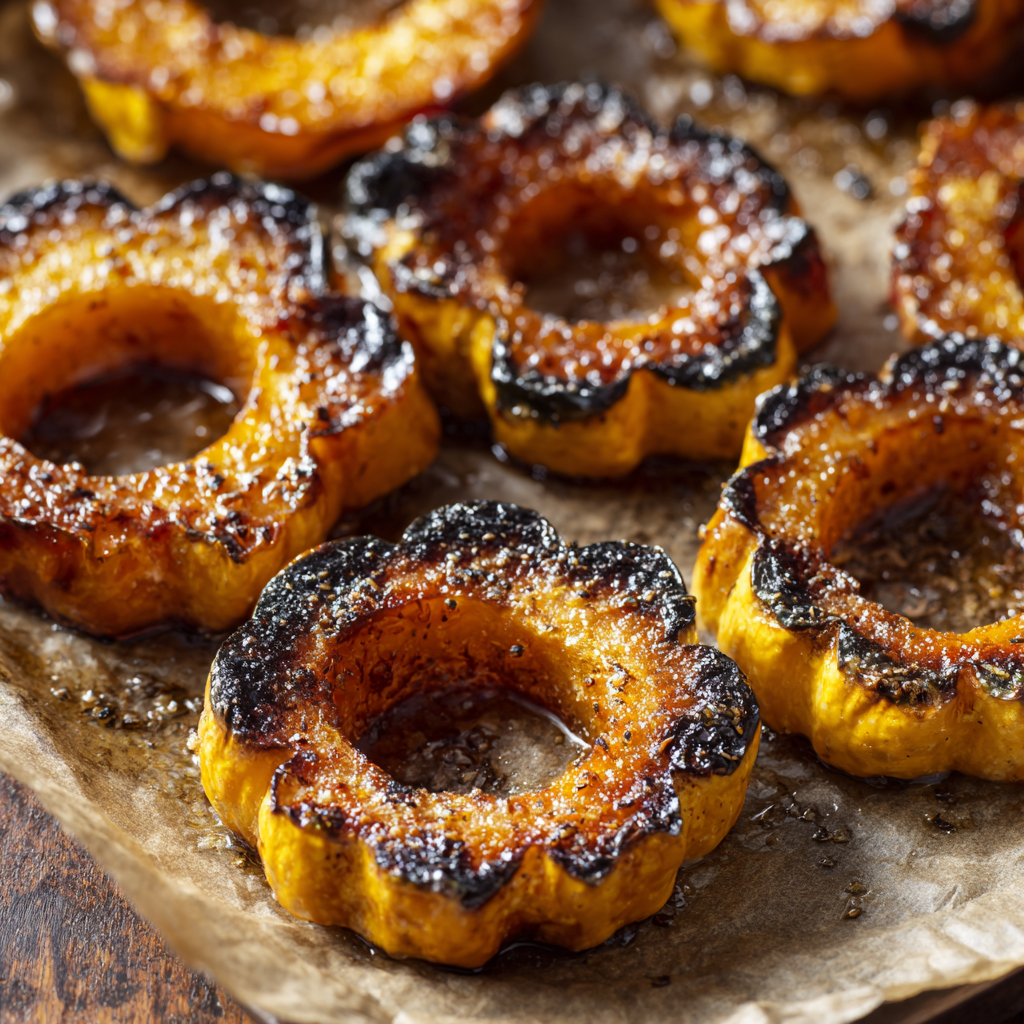
Maple-Glazed Acorn Squash Rings
Welcome, Fall! Let’s Make Some Maple-Glazed Acorn Squash Rings
Hey there, friend! Come on in, the oven’s preheated and the kitchen is smelling like a dream already. Is there anything that truly captures the essence of autumn more than the warm, nutty aroma of roasting squash? It’s the kind of smell that wraps you up in a cozy hug, promising a meal that’s as comforting as it is delicious. If you’re looking for a side dish that’s going to absolutely steal the show at your next dinner—be it a casual Tuesday night or the big holiday feast—you’ve landed on the perfect recipe.
Today, we’re transforming a humble, gorgeous acorn squash into something truly spectacular: Maple-Glazed Acorn Squash Rings. We’re not just roasting chunks here; we’re creating beautiful, caramelized rings that are as much a feast for the eyes as they are for the belly. The magic happens when a simple, sweet-and-spicy glaze meets the high heat of the oven, creating tender, buttery squash with crispy, caramelized edges that are downright irresistible. This isn’t just a recipe; it’s a little piece of edible autumn art, and I promise it’s so much easier to make than it looks. So, grab your favorite apron (the messy one with all the character!), and let’s make something beautiful together.
A Ring of Autumn Memories
This recipe always takes me right back to my first tiny apartment kitchen. It was my first real autumn living on my own, and I was determined to host a “Friendsgiving.” My budget was… well, let’s call it “cozy,” just like the apartment. I wanted to make a stunning, impressive side dish without breaking the bank. A beautiful, ridged acorn squash caught my eye at the farmer’s market, and inspiration struck. Instead of struggling to chop it into precarious cubes, I thought, “Why not just slice it?”
I remember the challenge of sawing through that first tough squash, the seeds scattering on my counter, and the hopeful brush of my hastily made maple glaze. The moment I pulled those glistening, golden rings out of the oven, I knew I had something special. They were the unanimous hit of the dinner! That night, surrounded by laughter and good friends, I learned a powerful kitchen lesson: the most memorable dishes aren’t about the fanciest ingredients; they’re about a clever idea, a little bit of love, and the joy of sharing. Every time I make these rings, I get a little glimpse of that memory, and it tastes just as sweet as the maple glaze.
Gathering Your Autumn Palette: The Ingredients
One of the best things about this dish is its beautiful simplicity. Each ingredient plays a crucial role in building that deep, comforting flavor profile. Here’s what you’ll need:
- 1 large acorn squash: This is our star! Look for one that feels heavy for its size and has a deep green rind with a patch of orange (a sign of perfect ripeness). The skin is totally edible once roasted, adding a wonderful texture. Chef’s Insight: No acorn squash? Butternut squash will work, though it’s harder to slice into rings. You’d be better off slicing a large butternut squash in half crosswise and using the wider, top half for rings.
- 2 tablespoons olive oil: This helps the glaze adhere, promotes caramelization, and prevents sticking. Substitution Tip: Avocado oil or melted coconut oil are fantastic neutral-tasting alternatives.
- 2 tablespoons pure maple syrup: Please, please use the real stuff! The complex, caramel-like notes of pure maple syrup are irreplaceable. Pancake syrup just won’t give you the same depth of flavor. Chef’s Insight: The grade doesn’t matter hugely; Grade A Amber Color and Rich Taste is my go-to for its balanced flavor.
- 1 tablespoon brown sugar: This little bit of brown sugar works with the maple to create a deeper, more complex sweetness and helps the edges get extra crispy and candied. Substitution Tip: Coconut sugar works beautifully for a less refined option.
- ½ teaspoon ground cinnamon: The quintessential warm spice that just screams “fall.” It pairs perfectly with the sweet squash and maple.
- ¼ teaspoon salt: Absolutely essential! Salt is not optional here; it balances the sweetness and makes all the other flavors pop. I use fine sea salt.
- Pinch of black pepper or cayenne (optional): This is my favorite secret weapon! A tiny pinch of either one adds a subtle, intriguing warmth in the background that keeps the dish from being one-dimensionally sweet. Highly recommended!
Let’s Get Cooking: Creating Your Edible Masterpiece
Don’t let the beautiful presentation fool you—this process is straightforward and oh-so-satisfying. Follow these steps, and you’ll have a perfect result every single time.
- Preheat and Prep: Fire up your oven to 400°F (200°C). This high heat is key for getting those gorgeous caramelized edges without steaming the squash. While it heats, line a large, rimmed baking sheet with parchment paper. Chef’s Hack: Parchment paper is a lifesaver for easy cleanup. If you don’t have any, you can grease the pan lightly, but parchment is best to prevent any sticking.
- Conquer the Squash: This is the trickiest part, but you’ve got this! Using a sharp, sturdy chef’s knife, carefully slice about ½-inch to ¾-inch off the stem end and the bottom of the squash. This creates flat, stable surfaces. Stand the squash upright on one of its now-flat ends. Carefully slice straight down through the squash to create ½-inch thick rings. Chef’s Hack: If the squash is being stubborn, pop it in the microwave for 60-90 seconds first to slightly soften the skin. It makes a world of difference!
- Scoop the Seeds: Use a small spoon, a melon baller, or even a grapefruit spoon to scoop out the seeds and stringy pulp from the center of each ring. Don’t toss those seeds! You can clean them, toss them with a little oil and salt, and roast them on a separate pan for a delicious snack.
- Whisk the Magic Glaze: In a small bowl, combine the olive oil, pure maple syrup, brown sugar, cinnamon, salt, and that optional pinch of pepper or cayenne. Whisk it until it’s completely smooth and emulsified. Give it a taste—this is the fun part! It should be sweet, spiced, and balanced.
- Glaze Those Rings: Using a pastry brush (or just your hands—no judgment here!), generously brush the glaze onto both sides of each squash ring. Make sure every nook and cranny gets coated. This is what creates that incredible flavor crust. Arrange the rings in a single layer on your prepared baking sheet. Chef’s Tip: Don’t crowd the pan! If they’re too close, they’ll steam instead of roast. Use two sheets if you need to.
- Roast to Perfection: Slide that beautiful pan into your preheated oven. Set your timer for 15 minutes. When it goes off, pull the sheet out (close the oven door!) and carefully flip each ring over. You’ll see they’re already starting to transform, with the edges browning. Pop them back in for another 10-15 minutes. They’re done when they are fork-tender, deeply golden brown, and the edges are slightly crispy. Your kitchen will smell absolutely heavenly.
Plating Your Autumn Masterpiece
Presentation is part of the fun with this dish! For a family-style vibe, simply arrange the warm, glistening rings overlapping slightly on a beautiful platter. Drizzle any of the sticky, delicious glaze left on the pan right over the top. For individual plates, you can stack 2-3 rings as a stunning base for your main protein. I love placing a perfectly seared pork chop or a juicy roasted chicken thigh right in the center. A final flourish of fresh, chopped parsley or a few crispy roasted sage leaves adds a pop of color and freshness that takes it over the top.
Make It Your Own: Delicious Twists & Swaps
The beauty of this recipe is its versatility. Feel free to play and adapt it to your taste or dietary needs!
- Savory Herb Delight: Swap the cinnamon for a teaspoon of chopped fresh rosemary or thyme. Use all olive oil and skip the brown sugar for a more savory, herbaceous version that’s incredible with roast chicken or turkey.
- Spicy Maple Kick: Love heat? Increase the cayenne to ⅛ or even ¼ teaspoon, or add a pinch of red pepper flakes to the glaze. The sweet-spicy combo is addictive.
- Nutty Crunch: Before serving, sprinkle the rings with toasted pecans, walnuts, or pepitas for a wonderful crunch and extra layer of nutty flavor.
- Dairy-Free “Buttery” Finish: For an extra rich finish, brush the rings with a little melted vegan butter mixed with the maple syrup when they come out of the oven.
- Apple Cider Twist: Replace one tablespoon of maple syrup with reduced apple cider for a fantastic autumnal flavor fusion.
Olivia’s Chef Notes & Kitchen Stories
This recipe has been a work in progress over the years. My first attempt, I was so scared of undercooking that I left them in for nearly 45 minutes. Let’s just say we had maple-glazed acorn squash *chips* that year. Crispy, but not exactly the tender-crisp texture we’re going for! The flip-halfway method was the game-changer that gave me the perfect texture every time.
Another funny story: I once tried to get fancy and use a cookie cutter to create star-shaped holes in the center of the rings for a holiday party. It was a adorable idea, but the squash was too firm, and I nearly launched a star-shaped piece of squash across the kitchen. We settled for beautifully rustic rings that night, and honestly, they were perfect. The moral of the story? Sometimes the simplest preparation is the most elegant. Don’t overcomplicate it. Embrace the beautiful imperfection of homemade food—it has more character!
Your Questions, Answered!
Q: My squash is really tough to cut. Any tips?
A: Absolutely! This is the most common hurdle. Here are my top tricks: 1) Microwave the whole squash for 1-2 minutes to slightly soften the skin. 2) Use a large, sharp chef’s knife, not a small paring knife. 3) Place a kitchen towel under your cutting board to prevent it from slipping. 4) If you’re still nervous, you can carefully halve the squash lengthwise, scoop the seeds, and then place each half cut-side down to slice into half-moons. They’ll be just as delicious!
Q: My glaze is burning before the squash is tender. What happened?
A: This usually means your oven is running hot, or your rings are cut too thin. Ovens can vary, so an oven thermometer is a great cheap tool to check its accuracy. If the edges are getting too dark too fast, simply reduce the oven temperature to 375°F (190°C) for the remainder of the cooking time. Next time, try cutting slightly thicker rings, around ¾-inch.
Q: Can I make these ahead of time?
A: You can partially prep ahead! You can slice the squash and scoop the seeds up to a day in advance. Keep the rings stored in an airtight container in the fridge. The glaze can also be whisked together and stored at room temperature. I highly recommend roasting them fresh right before serving for the best texture, but you can reheat them in a 350°F (175°C) oven for 10 minutes if needed.
Q: Is the skin really edible?
A: Yes, once roasted, the skin of an acorn squash becomes tender and completely enjoyable to eat. It adds great texture and fiber! If you really dislike it, you can scoop the soft flesh away from the skin after roasting, but I encourage you to try it.
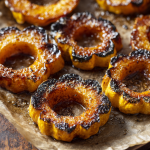
Maple-Glazed Acorn Squash Rings
Description
Golden, caramelized squash with crispy edges, kissed by maple syrup and warm spices—this dish brings pure fall comfort to your table. Whether you’re hosting a holiday feast or just craving something cozy on a weeknight, these squash rings are as beautiful as they are delicious.
Ingredients
-
1 large acorn squash
-
2 tbsp olive oil (or avocado/coconut oil)
-
2 tbsp pure maple syrup
-
1 tbsp brown sugar (or coconut sugar)
-
½ tsp ground cinnamon
-
¼ tsp fine sea salt
-
Pinch black pepper or cayenne (optional, for warmth)
Optional Garnishes: toasted pecans/walnuts/pepitas, fresh parsley, or crispy sage leaves
Instructions
-
Prep Oven & Pan – Preheat oven to 400°F (200°C). Line a large baking sheet with parchment paper.
-
Slice Squash into Rings – Trim stem + base, stand squash upright, and cut into ½-inch rings. Scoop out seeds. (Microwave squash 1–2 mins first if too tough to cut!)
-
Mix Glaze – Whisk olive oil, maple syrup, brown sugar, cinnamon, salt, and optional pepper/cayenne until smooth.
-
Coat Rings – Brush glaze over both sides of each ring. Arrange in a single layer on the baking sheet (don’t crowd).
-
Roast – Bake 15 mins, flip, then roast another 10–15 mins until tender, golden, and caramelized at the edges.
-
Serve – Arrange on a platter, drizzle with pan glaze, and sprinkle with optional garnishes.
Notes
-
For extra crunch, sprinkle roasted nuts or seeds before serving.
-
Want savory? Swap cinnamon for fresh rosemary or thyme.
-
Too sweet? Add more cayenne or red pepper flakes for a sweet-spicy kick.
Nutrition
- Calories: 140 cal Per Serving
- Sugar: 10g
- Fat: 5g
- Carbohydrates: 25g
Nutritional Information*
*This is an estimate for 1 serving (approximately 3-4 rings) and will vary based on specific ingredients used.
Per Serving: Calories: 140 | Fat: 5g | Saturated Fat: 1g | Cholesterol: 0mg | Sodium: 120mg | Carbohydrates: 25g | Fiber: 3g | Sugar: 10g | Protein: 1g
Final Thoughts
This recipe for Maple-Glazed Acorn Squash Rings is so much more than a list of ingredients and instructions. It’s an invitation to slow down and engage with the season. It’s about appreciating the history and nutrition held within a simple squash, understanding the beautiful science that transforms it in your oven, and embracing the creativity it can inspire in your weekly cooking. This dish represents the heart of autumn cooking: warmth, comfort, simplicity, and a touch of magic. It’s a reminder that the most memorable meals aren’t about complexity, but about heart, a little bit of knowledge, and the joy of sharing something truly good. I hope this recipe finds its way onto your table again and again, creating new cozy memories with every delicious, caramelized bite.
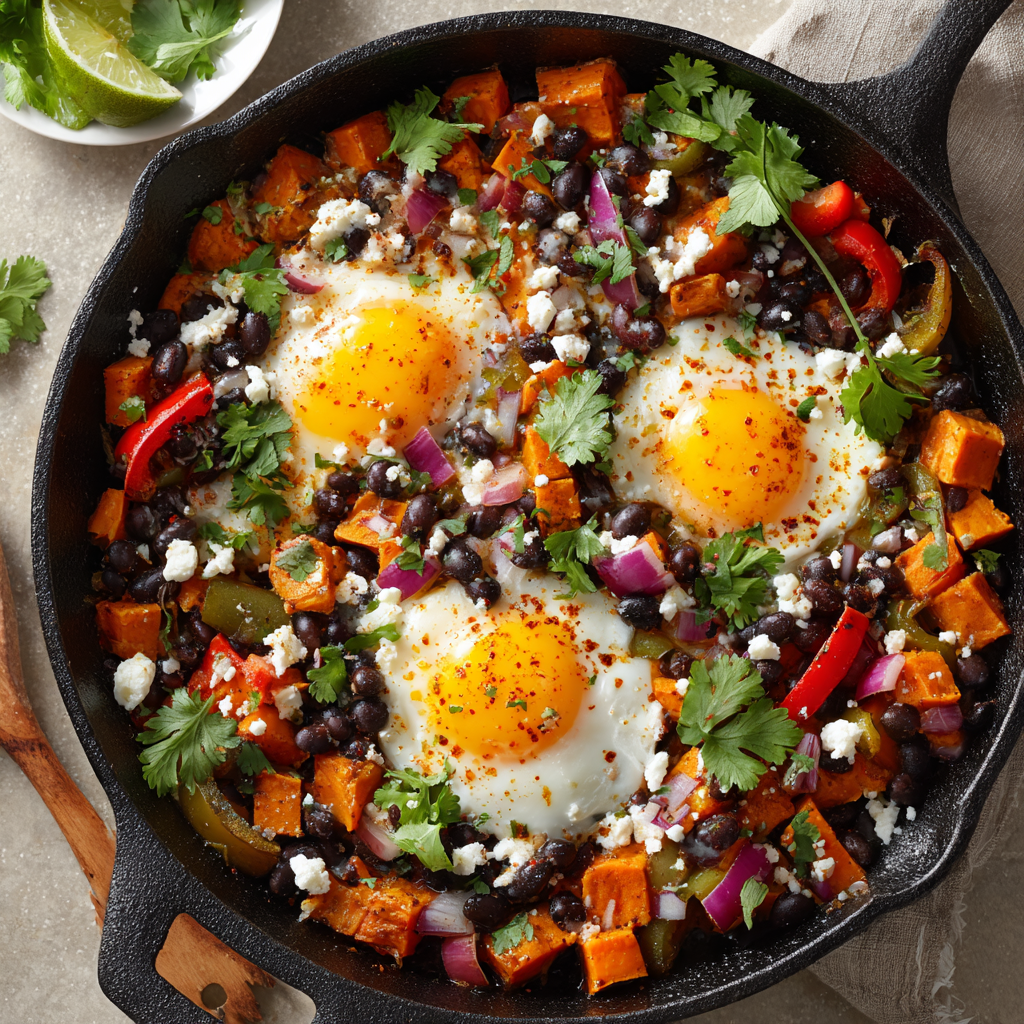
Sweet Potato & Black Bean Breakfast Skillet
Rise, Shine, and Sizzle: Your New Breakfast Obsession Awaits!
Good morning, sunshine! Can you smell that? It’s the cozy aroma of crispy sweet potatoes dancing with smoky spices in my trusty cast iron skillet – and it’s whispering your name. If your mornings usually involve frantic cereal-pouring or sad desk pastries, let me introduce you to your new kitchen BFF: this Sweet Potato & Black Bean Breakfast Skillet. Picture this: golden sweet potato cubes, plump black beans, and colorful veggies caramelizing together, topped with a perfectly baked egg that oozes golden yolk when you dive in. Finished with creamy queso fresco and confetti-fresh cilantro? Honey, this isn’t just breakfast – it’s a vibe.
As your self-appointed breakfast hype-woman, I promise this dish is the ultimate game-changer. It’s:
- Lazy Sunday approved: One pan = minimal cleanup (we stan that energy)
- Plant-powered joy: Packed with fiber and protein to keep you buzzing till lunch
- Brunch MVP: Impress guests without breaking a sweat (or waking up at dawn!)
No fancy skills required – just grab a fork and let’s make magic happen. Trust me, once you taste that smoky-sweet-spicy combo with a runny yolk? You’ll be doing a happy dance in your slippers. Ready to turn your morning routine into a flavor fiesta? Let’s get sizzling!
How a Rainy Morning in Austin Inspired This Skillet Love Affair
Let me take you back to a drizzly weekend in Austin – I was visiting my college bestie, Maya, who’s basically the queen of “chill brunch vibes.” We’d stayed up too late laughing over old photos (and maybe one too many margs), woke up starving, and raided her pantry like raccoons. All we found? A lonely sweet potato, a can of black beans, and some sad-looking peppers. Challenge accepted! We diced, sizzled, and cracked eggs right into the skillet, giggling as the spices made us sneeze. When we took that first bite – crispy sweet potatoes, smoky beans, creamy yolk blending with tangy cheese – we froze. “Holy wow,” Maya mumbled through a full mouth. “This is stupid good.”
That messy, unplanned kitchen moment became our ritual. Now, whenever I make this skillet, I’m transported back to her tiny apartment: rain pattering, Stevie Wonder playing, and that magical first bite. It’s proof that the best recipes aren’t born from perfection – they’re born from hungry improvisation and shared joy. Every time I drizzle the oil into that pan, I smile. Here’s to kitchen accidents that taste like happiness!
Gather Your Flavor Crew: Ingredients & Pro Tips
Don’t stress if your pantry isn’t Instagram-perfect – I’ve got swaps for days! Here’s what you’ll need (and why):
- 1 large sweet potato, diced (½-inch cubes) – The star! Smaller cubes = faster cooking. Swap with butternut squash if needed.
- ½ cup black beans, drained & rinsed – Canned is fine (no shame!). Rinsing removes that metallic tang. Kidney beans work too!
- ½ bell pepper, diced (any color!) – Red/yellow add sweetness, green for bite. Zucchini or mushrooms rock here too.
- ¼ red onion, chopped – Soaks up spices beautifully. Yellow onion or shallots are great subs.
- ½ tsp cumin + ¼ tsp smoked paprika – Non-negotiables! Smoked paprika adds campfire magic. Regular paprika? Sad trombone noise.
- Pinch of chili flakes – Your heat dial! Omit or double it. Chipotle powder adds smoky heat.
- Salt & black pepper – Season in layers! Taste after adding beans.
- 1–2 eggs – Farm-fresh if possible – that yolk color!
- 2 tbsp crumbled queso fresco – Salty creaminess. Cotija or feta work. Vegan? Smashed avocado!
- Fresh cilantro, chopped – The confetti finish! Hate cilantro? Try parsley or green onions.
Chef’s Grocery Hack: Short on time? Pre-diced sweet potatoes from the produce section are your friend! Just adjust cook time.
Let’s Make Magic: Step-by-Step with Chef Secrets!
Grab your favorite oven-safe skillet (cast iron is my ride-or-die!) and let’s do this:
- Sauté the Veggies: Heat 1 tbsp oil (avocado or olive) over medium heat. Add sweet potatoes. Chef’s secret: Spread them in one layer – no crowding! This ensures caramelization, not steaming. Cook 8 minutes, stirring only 2-3 times. Patience = crispiness! Add onions and peppers. Cook 5 minutes until onions are glassy and peppers soften. “Why add them later?” Onions burn faster than sweet potatoes – we want golden, not charcoal!
- Beans & Spice Time! Reduce heat to medium-low. Add beans, cumin, smoked paprika, chili flakes, ½ tsp salt, and ¼ tsp pepper. Stir gently – beans are delicate! Cook 2 minutes. Pro tip: Smash a few beans against the pan – they thicken the mix and add creaminess! Taste and adjust salt – beans can be salty.
- Egg-citing Addition: Make 1-2 small “wells” in the mixture using a spoon. Crack eggs directly into wells. BIG hack: Sprinkle a tiny pinch of salt over the raw egg whites – it helps them set faster and prevents rubberiness!
- Bake to Perfection: Transfer skillet to a preheated 375°F (190°C) oven. Bake 6-8 minutes. Watch closely! For runny yolks: 6 mins. Jammy yolks: 7 mins. Set yolks: 8 mins. No oven-safe pan? Cover with a lid on the stovetop on low heat for 5-7 mins.
- Grand Finale: Carefully remove skillet (HOT handle alert! I wrap mine in a towel). Sprinkle with queso fresco and cilantro. Chef’s flair: Add a lime wedge on the side – a squeeze brightens everything!
Safety PSA: That skillet handle stays HOT long after baking. Always use a dry towel or silicone handle cover!
Plating Like a Pro (Minimal Effort, Max Style!)
This beauty is meant to be served straight from the skillet – rustic charm for the win! Place it on a trivet in the center of the table and let everyone dig in family-style. Pair it with:
- Warm corn tortillas or crusty bread for scooping
- Avocado slices or a dollop of cool sour cream/Greek yogurt
- A drizzle of hot honey or your favorite hot sauce (Cholula is my jam!)
- Simple side salad with lime vinaigrette
Morning coffee? Absolutely. Mimosa? Even better. This skillet turns any table into an instant brunch party!
Mix It Up! 5 Delicious Twists
This recipe is your culinary playground! Try these fun spins:
- Southwest Fiesta: Add ½ cup corn kernels and swap queso fresco for pepper jack. Top with chunky salsa!
- Vegan Powerhouse: Skip the egg. Add ½ cup crispy tofu crumbles tossed in turmeric (for “eggy” color) and nutritional yeast. Use vegan feta.
- Meat Lover’s Dream: Brown ¼ lb spicy chorizo with the onions. Hello, smoky depth!
- Mediterranean Mood: Swap black beans for chickpeas, cumin for oregano, and top with feta & kalamata olives.
- Sweet & Savory: Add 1 diced apple with the sweet potatoes and a pinch of cinnamon. Trust me!
Olivia’s Kitchen Confessions & Evolution
This skillet has seen some glow-ups! Version 1.0 involved tragically overcooked sweet potatoes and an egg that vanished under beans (RIP). Over time, I learned: dice smaller, season louder, and respect the egg well. The biggest game-changer? Smoked paprika. That first time I used it? Mind. Blown. It transformed the dish from “nice” to “WHERE HAVE YOU BEEN ALL MY LIFE?!”
True story: Once, mid-brunch with friends, I grabbed the skillet handle bare-handed after baking. Cue dramatic oven-mitt-less flailing and a very dignified “HOT-HOT-HOT!” dance. Lesson learned: Always announce hot handles like a town crier! Now, it’s my most-requested recipe for potlucks. Watching friends go quiet after the first bite, eyes wide? That’s the good stuff. That’s why we cook.
Your Questions, Answered!
Let’s tackle common kitchen hiccups:
Q: Help! My sweet potatoes are still hard after 8 minutes. What gives?
A: No panic! Dice size is key – aim for ½-inch cubes. If they’re stubborn, add 1-2 tbsp water to the pan, cover with a lid for 3-4 mins (steam softens them!), then uncover to crisp up. Next time, microwave diced potatoes for 2 mins before sautéing.
Q: Can I prep this ahead for crazy mornings?
A: Absolutely! Sauté the veggie/bean mix (without eggs) and store for 3 days. Reheat in a skillet, make wells, crack eggs, and bake/cover as directed. Fresh eggs are non-negotiable for that perfect texture!
Q: I don’t have an oven-safe skillet. Disaster?
A> Nope! Sauté everything in a regular pan. Transfer the mix to a greased small baking dish, make wells, add eggs, and bake. It’s just as delicious (minus the rustic cred).
Q: My egg whites are still runny after baking?
A: Oven temps vary! Pop it back in for 1-2 minute intervals. Pro tip: For faster setting, spoon a little hot veggie mix over the egg whites halfway through baking.
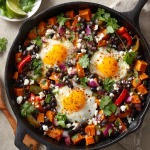
Sweet Potato & Black Bean Breakfast Skillet
- Total Time: 30 mins
Description
Golden, crispy sweet potatoes, smoky black beans, and caramelized veggies all sizzle together in one skillet—finished with a runny-yolk egg, creamy queso fresco, and fresh cilantro. This breakfast isn’t just fuel, it’s a vibe: hearty, colorful, and packed with bold flavor. Whether you’re brunching with friends or powering up for a busy day, this skillet is your new go-to morning ritual.
Ingredients
-
1 large sweet potato, diced (½-inch cubes)
-
½ cup black beans, rinsed & drained
-
½ bell pepper, diced
-
¼ red onion, chopped
-
½ tsp cumin
-
¼ tsp smoked paprika
-
Pinch chili flakes (optional)
-
Salt & black pepper, to taste
-
1–2 eggs
-
2 tbsp queso fresco (or feta/cotija)
-
Fresh cilantro, chopped
-
1 tbsp oil (avocado or olive)
Optional: lime wedges, tortillas, hot sauce, avocado slices
Instructions
-
Sear the Sweet Potatoes – Heat oil in an oven-safe skillet over medium. Add potatoes in a single layer; cook 8 mins, stirring occasionally, until golden and tender.
-
Add Veggies – Stir in onions and peppers. Cook 5 mins until softened.
-
Spice & Beans – Lower heat. Stir in beans, cumin, paprika, chili flakes, salt, and pepper. Mash a few beans for creaminess.
-
Egg Time – Make small wells in the mix. Crack in eggs. Sprinkle a little salt over whites.
-
Bake – Transfer skillet to 375°F oven. Bake 6–8 mins: 6 for runny yolks, 8 for set. (No oven-safe skillet? Cover and cook on stovetop.)
-
Finish & Serve – Top with queso fresco, cilantro, and lime. Serve straight from skillet with warm tortillas or toast.
Notes
Dice sweet potatoes small for faster cooking. Want to spice it up? Swap chili flakes for chipotle powder and drizzle with hot honey for a smoky-sweet kick.
- Prep Time: 10 mins
- Cook Time: 20 mins
Nutrition
- Calories: 320 cal Per Serving
- Fat: 14g
- Carbohydrates: 34g
Fuel Your Morning (The Delicious Way!)
Per Serving (1 egg version): ~320 calories | 14g fat | 34g carbs | 13g protein | 8g fiber
This powerhouse packs complex carbs for energy, plant-based protein & fiber to keep you full, and healthy fats from the egg and oil. It’s gluten-free naturally and easily adaptable for vegan diets!
Final Thoughts
The journey of a meal is often more than the sum of its ingredients. This Sweet Potato & Black Bean Breakfast Skillet is a perfect example. It’s a recipe that delivers on every practical level: it’s nutritious, efficient, customizable, and deeply satisfying. But it also represents something more. It’s a story of friendship and a happy accident in a Austin kitchen. It’s a lesson in nutritional science and a template for building culinary confidence. It’s a passport to global flavors, connecting your morning routine to traditions from around the world.
This dish proves that the best food doesn’t require complexity or expensive ingredients. It requires a willingness to experiment, to trust your palate, and to find joy in the process. It’s a celebration of how a single pan can create not just a meal, but a moment—a moment of warmth, comfort, and shared connection. So, as you take that first bite of crispy sweet potato and runny yolk, remember that you’re not just eating breakfast. You’re participating in a global ritual of morning nourishment, you’re fueling your body with intelligent intention, and you’re creating your own kitchen story, one delicious, sizzling skillet at a time.
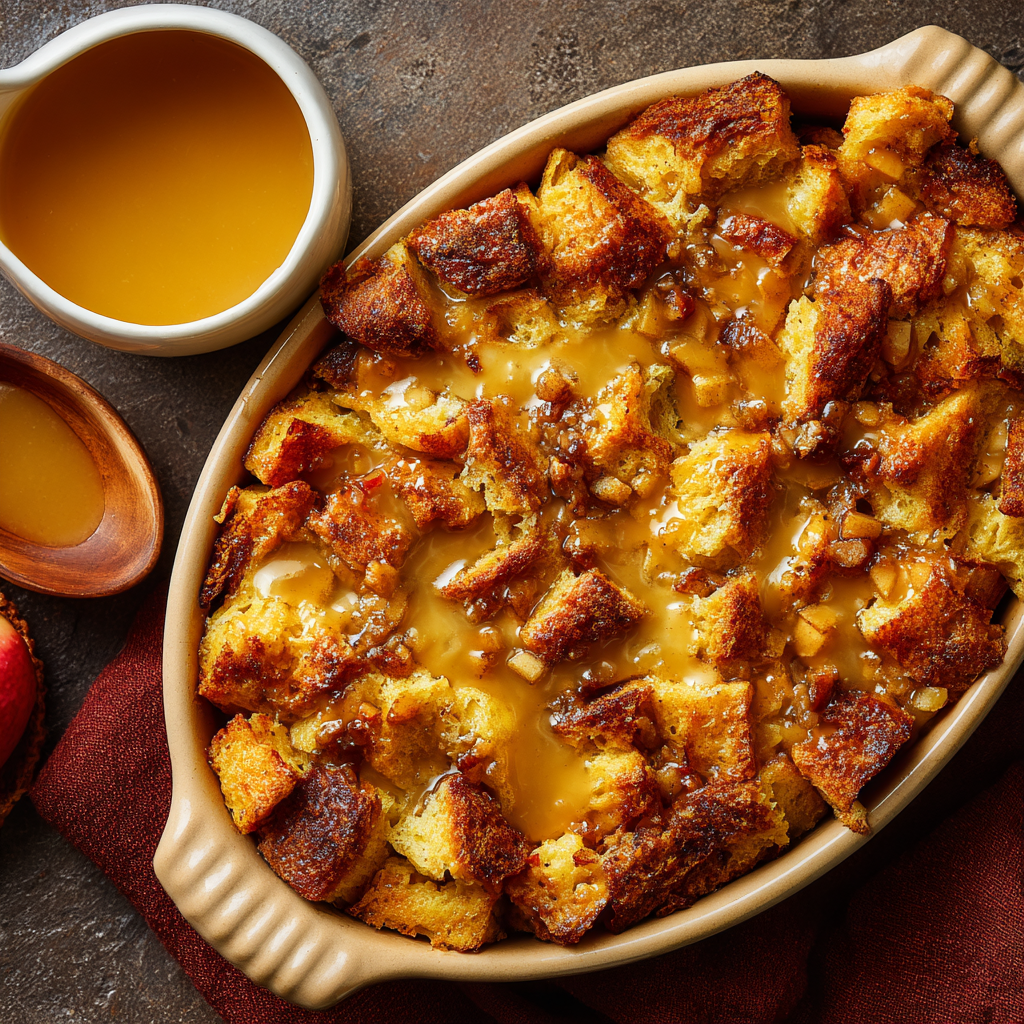
Apple Cider Overnight French Toast Casserole
Welcome to My Cozy Fall Kitchen!
Hey there, friend! Olivia here, apron slightly dusted with cinnamon and probably a smudge of maple syrup on my cheek. Can you smell that? It’s the warm, spicy-sweet scent of fall wafting through my kitchen, and it’s all thanks to my absolute favorite breakfast miracle: Apple Cider Overnight French Toast Casserole. If you’ve ever wished you could bottle up autumn mornings—crisp air, golden light, and that feeling of pure comfort—this dish is your magic wand. Picture this: fluffy bread soaked in a spiced apple cider custard, transforming overnight into a caramelized, pudding-like hug on a plate. No fancy skills needed, just a loaf of bread and that joyful “aha!” moment when you pull this beauty from the oven. Whether you’re hosting brunch or treating your crew to a slow Saturday, this casserole turns “just breakfast” into a memory-maker. Let’s dive in—I promise, your future self (sipping coffee while this bakes) will thank you!
The Apple Orchard Epiphany
This recipe? It’s pure nostalgia with a side of happy accidents. Years ago, my family visited a Vermont apple orchard on a leaf-peeping trip. We returned home with gallons of fresh cider and a craving for something warm. I’d planned classic French toast, but—plot twist!—my toddler decided midnight was party time. Exhausted, I dumped everything into a dish, shoved it in the fridge, and prayed. The next morning? Magic. That casserole emerged puffed and golden, filling our kitchen with a scent so cozy, my husband declared it “autumn on a fork.” Now, it’s our first-day-of-fall tradition. Every bite tastes like crunchy leaves, flannel shirts, and that giddy feeling when you find the perfect pumpkin. It’s not just food; it’s a time machine to joy.
Your Autumn Flavor Toolkit
Grab these simple stars—each one’s a fall MVP! Pro tip: Measure everything the night before for stress-free assembly.
- 1 loaf French or challah bread (stale!) – Chef’s insight: Stale bread soaks up custard like a dream! Challah adds buttery richness, French bread gives structure. Swap: Brioche or gluten-free sourdough.
- 4 large eggs – Chef’s insight: Your custard’s backbone! Room temp blends smoother.
- 1 ¼ cups apple cider – Non-negotiable! Reduces to intensify flavor. Swap: Apple juice in a pinch (add ½ tsp cider vinegar for tang).
- ¾ cup milk – Whole milk = luxury texture. Dietary swap: Almond or oat milk work great!
- ¼ cup maple syrup – Secret weapon: Use dark grade for caramel notes. Swap: Honey or brown sugar.
- 1 tsp cinnamon + ¼ tsp nutmeg – Pro tip: Freshly grated nutmeg? Game-changer.
- 1 tsp vanilla extract – Balances acidity. Always use pure vanilla!
Let’s Build Your Brunch Masterpiece!
Ready for the easiest “wow” moment ever? Follow these steps—I’ve tucked in all my kitchen hacks!
- Prep the Base: Grease a 9×13-inch baking dish with butter or non-stick spray. Cube your bread into 1-inch pieces—slightly uneven is fine! Chef’s hack: Spread cubes on a baking sheet for 20 minutes if not stale. Toss ’em in the dish like confetti!
- Whisk the Custard: In a big bowl, whisk eggs until yolks and whites are BFFs. Pour in cider, milk, maple syrup, vanilla, cinnamon, and nutmeg. Whisk until it’s smoother than a jazz playlist. Pro tip: Taste a drop! Adjust spices if needed.
- Soak & Dream: Slowly pour custard over bread. Gently press down with a spatula—think “tucking in a blanket,” not squishing! Every cube should blush with liquid. Cover tightly with foil. Refrigerate overnight (8-12 hours). Chef’s secret: Rotate dish once if your fridge slopes!
- Bake to Golden Glory: Next morning, preheat oven to 350°F (175°C). Remove dish from fridge while oven heats—20 minutes avoids thermal shock! Bake UNCOVERED for 40-45 mins. Doneness test: Center should spring back lightly. Edges will be crisp and caramelized!
- Rest & Revel: Let casserole sit 5-10 minutes before serving. It deflates slightly (totally normal!), making it easier to slice. Emergency hack: If top browns too fast, tent loosely with foil.
Plating Like a Pro (Zero Effort Required!)
Slide a spatula under a generous square—custardy middle, crispy edges. Dust with snowy powdered sugar or drizzle with warm apple cider syrup (simmer 1 cup cider + ¼ cup maple syrup until thick!). For texture, scatter toasted pecans or sautéed cinnamon apples on top. Pair with hot coffee, a dollop of whipped cream, and big smiles. This dish shines family-style: plop the whole dish on the table and let everyone dig in!
The Science of Soaking: Why Overnight is Everything
You might be tempted to mix this casserole and pop it straight into the oven. I get it—the anticipation is real! But, my friend, the magic of this dish isn’t just in the ingredients; it’s in the wait. That overnight rest in the fridge isn’t a mere suggestion; it’s the alchemical process that transforms a simple bread-and-egg mixture into a sublime, custardy masterpiece. Let’s geek out for a moment on the beautiful science happening while you sleep.
It all starts with the star of the show: the bread. Stale, dry bread is not a mistake; it’s your secret weapon. Think of a day-old loaf as a thirsty sponge, its starch molecules having crystallized and hardened. When you pour that rich, spiced apple cider custard over it, the bread is desperate to rehydrate. It begins to greedily soak up the liquid, drawing the flavors of cider, maple, and spice deep into its very core. This initial absorption is good, but it’s only the beginning. If you baked it now, you’d get a decent result—a soft top with a potentially wet, eggy bottom. The flavors would be separate, each component distinct.
The overnight rest is where the true transformation occurs. This extended, cold soak allows for a process called osmosis and diffusion to work its magic. The moisture and flavor compounds from the custard don’t just coat the bread; they migrate evenly throughout every single cube, seeking equilibrium. The egg proteins, which will later set to create the custard’s structure, have time to fully penetrate the bread’s matrix. This slow, cold infusion means that come morning, every single bite, from the crispy top to the very center of the dish, will be uniformly flavorful and possess that coveted pudding-like texture.
Furthermore, the rest period is crucial for starch gelatinization. As the bread soaks, its starches begin to absorb the liquid and swell. When you finally bake it, these pre-hydrated starches will gelatinize more evenly and completely, creating that soft, cohesive, and melt-in-your-mouth interior that is the hallmark of a great baked French toast. Without this rest, the starches on the outside might gelatinize while the inside remains dry and tough.
Finally, let’s talk about the eggs. Whisking the custard creates tiny air bubbles. Letting the mixture rest allows these bubbles to largely dissipate. Why is that good? Because if you baked it immediately, those bubbles would expand in the oven, creating a soufflé-like rise that would then collapse into a rubbery, uneven texture. A rested custard bakes up dense, velvety, and luxuriously smooth. So, while it requires a dash of patience, the overnight soak is a non-negotiable step that does the heavy lifting for you. It’s the difference between a good breakfast and an unforgettable culinary experience that truly captures the deep, melded flavors of fall.
Beyond the Casserole: Crafting the Ultimate Fall Brunch Atmosphere
This Apple Cider Overnight French Toast Casserole is undoubtedly the star of the show, but creating a truly memorable autumn brunch is about crafting an entire experience. It’s about engaging all the senses and building a cozy, inviting atmosphere that makes your guests feel wrapped in the warmth of the season from the moment they walk in. Transforming your kitchen and dining space into a fall sanctuary is easier than you think, and it turns a simple meal into a cherished event.
Let’s start with the scent, which is arguably the most powerful sense for evoking memory and emotion. Of course, the casserole itself will be the main attraction, but you can begin building the aromatic narrative hours before. About an hour before your guests arrive, gently simmer a small pot of water on the stove with a few cinnamon sticks, orange peels, a handful of cloves, and a star anise pod. This natural “stovetop potpourri” will fill your home with an incredible, spicy-sweet fragrance that smells like pure, unadulterated autumn. It’s a natural and chemical-free alternative to scented candles that will have everyone commenting on how amazing your home smells before they even taste the food.
Next, set the scene with sight and touch. Embrace the cozy factor! Drape a soft, plush blanket over the back of a chair for someone to curl up with. Dim the overhead lights and rely on the warm, flickering glow of candles—think unscented pillar candles or a cluster of votives to avoid competing with your culinary and stovetop scents. The visual feast is just as important. Use your serveware to reflect the season. A rustic wooden board for any toppings, a beautiful ceramic pitcher for syrup, and earthy-toned plates and napkins in hues of burgundy, burnt orange, cream, or olive green instantly elevate the table. A simple centerpiece can be gathered from your backyard: a small wooden crate filled with fallen leaves, pinecones, and a few mini pumpkins or gourds.
Now, let’s build your supporting menu. While the casserole is hearty, offering a few light accompaniments creates balance and makes the meal feel more complete. A simple, crisp arugula salad with thin apple slices, red onion, candied pecans, and a bright apple cider vinaigrette provides a refreshing counterpoint to the rich, warm casserole. For a savory option, a platter of crispy bacon or sage-infused breakfast sausages is always a crowd-pleaser. And don’t forget the drinks! Offer a choice of rich, dark roast coffee, a selection of teas, and perhaps a carafe of warmed apple cider (spiked or not) for a truly festive touch.
Finally, curate the sound. Music is the invisible guest that sets the entire mood. Create a playlist filled with soft acoustic folk, relaxed jazz, or low-key indie music. Keep the volume low enough to allow for easy conversation—it should be a background hum that adds to the ambiance rather than dominates it. By thoughtfully considering each element—scent, sight, taste, touch, and sound—you build a holistic experience. The casserole becomes the delicious centerpiece of a much larger, wonderfully cozy moment of connection and autumn joy.
A Loaf of Your Own: The Art of Choosing and Prepping the Perfect Bread
In any strata or bread pudding-style dish, the bread is not just an ingredient; it’s the foundation. Its type, texture, and condition will determine whether your casserole is a resounding success or a soggy disappointment. While the recipe offers suggestions, understanding the why behind the bread choice empowers you to make the best decision every time, turning you from a recipe-follower into a kitchen intuitive.
First, let’s break down the ideal characteristics. You want a bread with a sturdy, well-structured crumb (the interior) and a firm crust. This structure is crucial because it needs to act like a network of tiny caves, capable of absorbing the rich custard without completely disintegrating into mush. The goal is for the bread to break down just enough to become soft and pudding-like, while still maintaining a slight bit of its integrity to provide a pleasing texture. This is why airy, ultra-soft sandwich bread is a poor choice—it has no structural integrity and will turn into a pasty, watery mess. The crust is also your friend! It adds flavor and, when baked, provides those delightfully chewy and caramelized bits throughout the dish.
Now, let’s meet the contenders:
-
Challah or Brioche: These enriched breads, made with eggs and often butter, are the luxury option. They are inherently tender, slightly sweet, and rich, making for an incredibly decadent and soft final product. The crumb is tight and uniform, leading to a very consistent, almost bread-pudding texture. If you’re aiming for ultimate indulgence, this is your pick.
-
French Bread or Baguette: This is the classic, reliable workhorse. With a chewier crust and a more open, airy crumb riddled with holes, it provides a fantastic textural contrast. It soaks up the custard beautifully but retains a slightly more distinct bite. You’ll notice the layers of soft custard and tender-but-present bread more than with challah. It’s excellent for those who dislike a uniformly soft texture.
-
Sourdough: The artisan’s choice. A good, crusty sourdough loaf brings its unique tangy flavor to the party, which creates a brilliant and sophisticated counterpoint to the sweet, spiced custard. Its robust crust and chewy crumb hold up exceptionally well. This is my go-to when I want a casserole that feels more complex and less purely sweet.
Regardless of your choice, the golden rule is STALE IS BEST. Fresh bread is too moist and its starch structure is too soft. It simply cannot absorb the custard properly, leading to a soupy, unbalanced bake. If you don’t have a day-old loaf, you must cheat! The best method is to cube your fresh bread and spread it in a single layer on a baking sheet. Bake it in a 300°F (150°C) oven for 10-15 minutes, tossing once, until it’s dried out and slightly toasted at the edges. Let it cool completely before using. This not only solves the moisture problem but also adds a deeper, toasty flavor base to your dish. Taking the time to properly select and prepare your bread is the single most important step you can take to ensure your casserole has the perfect texture, making it truly worthy of its centerpiece status.
Mix It Up! 5 Fun Twists
This casserole is your canvas—play with flavors!
- Caramel Apple: Layer bread with thin apple slices + swirl in ½ cup caramel sauce before baking.
- Protein Power: Add 1 cup cooked sausage crumbles or bacon bits to custard.
- Vegan Vibes: Swap eggs for flax eggs (4 tbsp ground flax + 10 tbsp water), use plant milk + vegan bread.
- Spiked Cider: Add 2 tbsp bourbon or rum to custard for grown-up coziness.
- Berry Bliss: Replace ½ cup cider with orange juice + add 1 cup fresh cranberries.
Olivia’s Extra Scoop
Confession: My first attempt was a soggy mess because I used fresh bread—lesson learned! Over the years, I’ve tweaked this like a mad scientist. Adding a splash of bourbon? Inspired by a Kentucky brunch trip. The cider reduction trick? Stolen from my grandma’s pie playbook. Leftovers? They’re mythical in my house, but if you manage to save some, reheat squares in a skillet with butter for epic “French toast bites.” Funny story: Once, my dog snatched a whole corner slice off the counter. Now, we call him the “quality control officer.” Moral: Guard your casserole fiercely!
Your Questions, Answered!
Q: Can I skip the overnight soak?
A: You *can* bake it after 30 minutes, but texture suffers. Overnight = deeper flavor absorption and custard perfection!
Q: Why is my casserole soggy in the middle?
A: Three culprits: 1) Bread wasn’t stale enough, 2) Oven temp too low (use an oven thermometer!), 3) Overcrowded dish. Fix: Bake 5-10 mins longer covered if top browns too fast.
Q: Can I freeze this?
A: Yes! Assemble (unbaked), freeze. Thaw overnight in fridge before baking. Baked leftovers freeze well too—reheat at 325°F.
Q: Help! I don’t have apple cider.
A: Simmer 1 cup apple juice + ½ tsp cinnamon + 1 tsp lemon juice until reduced to ¾ cup. Works in a pinch!
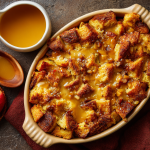
Apple Cider Overnight French Toast Casserole
- Total Time: 9 hrs
Description
Warm, spiced, custardy, and kissed with apple cider—this breakfast bake is like wrapping your taste buds in a flannel blanket. It’s effortless: prep the night before, pop it in the oven in the morning, and let your kitchen fill with the scent of fall magic. Perfect for lazy Saturdays, festive brunches, or whenever you want breakfast to feel like a cozy celebration.
Ingredients
-
1 loaf French bread or challah, cubed (stale works best)
-
4 large eggs
-
1 ¼ cups apple cider (reduce slightly for deeper flavor)
-
¾ cup milk (dairy or non-dairy)
-
¼ cup maple syrup
-
1 tsp cinnamon
-
¼ tsp nutmeg
-
1 tsp vanilla extract
Optional toppings: powdered sugar, sautéed apples, toasted pecans, or apple cider syrup
Instructions
-
Prep Bread – Grease a 9×13″ baking dish. Spread cubed bread evenly inside.
-
Make Custard – Whisk eggs, cider, milk, maple syrup, vanilla, and spices until smooth.
-
Soak Overnight – Pour custard over bread. Press down gently so cubes absorb liquid. Cover and refrigerate 8–12 hrs.
-
Bake – Next morning, preheat oven to 350°F (175°C). Bake uncovered 40–45 mins until puffed, golden, and center springs back lightly.
-
Serve & Enjoy – Rest 5–10 mins. Slice into squares, dust with powdered sugar, and drizzle with warm syrup or honey.
Notes
For extra indulgence, simmer 1 cup cider with ¼ cup maple syrup until syrupy, then drizzle over each serving. It’s like autumn’s answer to caramel sauce.
- Prep Time: 15 mins
- Cook Time: 45 mins
Nutrition
- Calories: 310 cal Per Serving
- Fat: 10g
- Carbohydrates: 44g
Nutritional Snapshot (Per Serving)
Serves 6–8 | Per Serving: ~310 calories | 10g fat | 44g carbs | 9g protein
Note: Includes custard base only. Toppings add extra calories.
Final Thoughts
This Apple Cider Overnight French Toast Casserole is so much more than a recipe to me. It’s a reminder that the most cherished moments often come from simple ingredients and a little bit of foresight. It’s a dish that embodies the very spirit of fall—anticipation, transformation, and warmth. It teaches a beautiful lesson: that sometimes, the best things require patience. That something truly wonderful can be built while you’re resting, that joy can be prepared in advance and simply baked off when the moment is right.
It’s a recipe that invites you to make it your own. Whether you stick to the classic version or embark on a new adventure with caramel, bourbon, or cranberries, you’re not just cooking; you’re creating a new tradition. You’re crafting a sensory experience that will become a part of your story—the story of cozy mornings, of gathered friends and family, of the unmistakable smell of cinnamon and apples that means home.
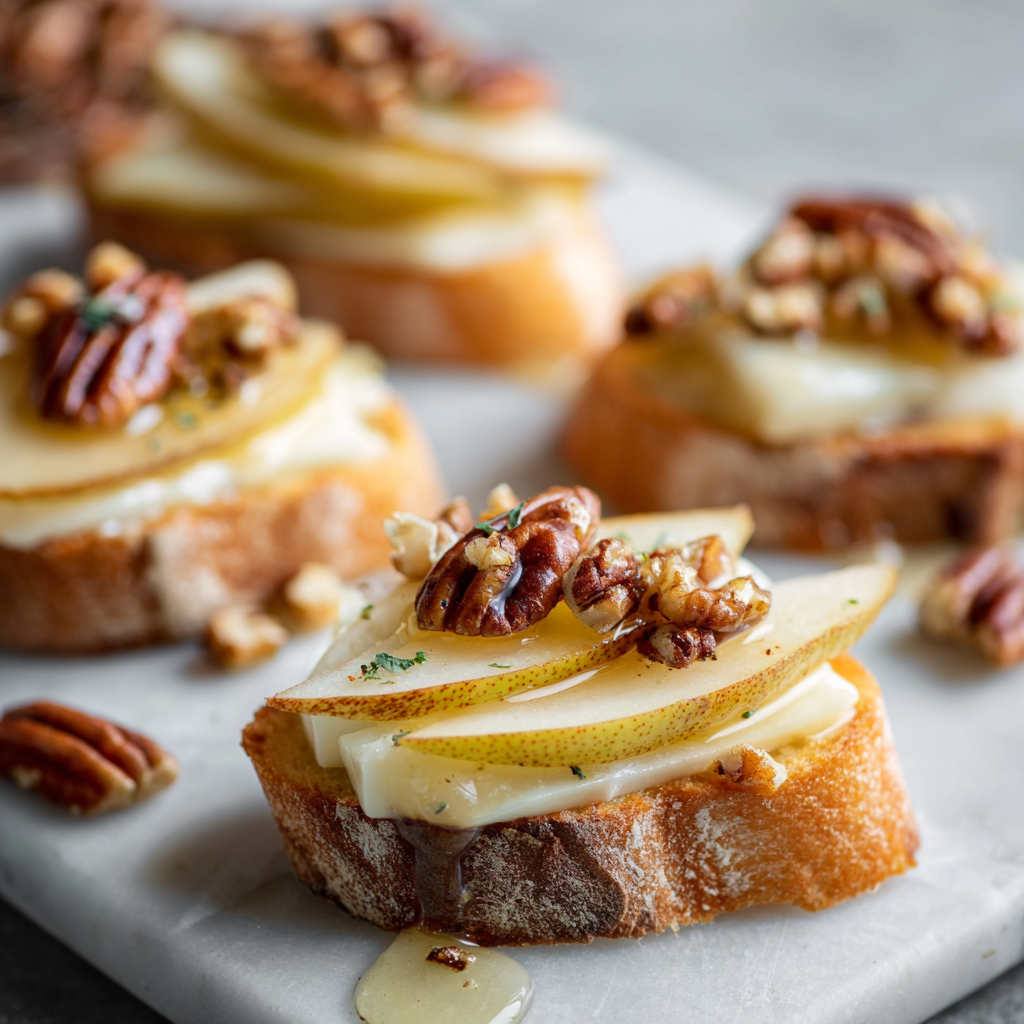
Pear & Brie Crostini
Welcome to My Cozy Kitchen: Let’s Make Magic with Pear & Brie Crostini!
Hey there, friend! Olivia here, apron slightly flour-dusted and heart full of excitement. Is there anything better than that moment when your kitchen fills with the warm, buttery scent of toasting bread and melting cheese? It’s like a hug for your soul, right? Today, we’re whipping up one of my all-time favorite party heroes (or Tuesday-night treat champions!): Pear & Brie Crostini. These little bites? Pure elegance meets “I totally got this” simplicity. Imagine: crisp, golden baguette slices, creamy Brie melting into sweet, juicy pears, a golden drizzle of honey, and that satisfying crunch of toasted pecans. They’re sweet, savory, creamy, crunchy – a flavor fiesta in every single bite! Whether you’re hosting book club, setting up a romantic charcuterie spread, or just treating yourself after a long day, these crostini are your secret weapon. They look like you fussed for hours, but spoiler alert: they come together faster than you can say “pass me another one!” So grab your favorite cutting board, put on some feel-good tunes, and let’s turn simple ingredients into something utterly unforgettable together. Ready? Let’s get toasty!
A Slice of Nostalgia: My First Crostini Triumph
Picture this: It was my first “grown-up” Friendsgiving, maybe ten years back. I was determined to impress but secretly terrified my contribution would be the flop of the night. I wanted something that whispered “sophisticated hostess” but screamed “effortlessly cool.” Enter the pear and Brie crostini! I remember nervously layering those pear slices, worrying the Brie was too oozy, and nearly spilling honey everywhere in my rush. When they came out of the oven, that magical aroma stopped conversations mid-sentence. My friend Marco grabbed one, took a bite, closed his eyes, and just mumbled, “Olivia… wow.” The whole platter vanished in minutes. That night, amidst the laughter and clinking glasses, I learned a powerful kitchen truth: the best dishes aren’t about perfection; they’re about heart, simple goodness, and sharing something deliciously real. These crostini became my signature “bring people together” bite. Every time I make them now, I’m transported back to that cozy, slightly chaotic apartment, surrounded by friends, feeling the pure joy of feeding people I love. That’s the magic we’re making today!
Gathering Your Flavor Squad: Ingredients & Insider Tips
Here’s everything you need for about 12 stunning crostini. Don’t stress about exactness – cooking’s an adventure!
- 1 Baguette (sliced into thin rounds): The crispy foundation! A day-old baguette works wonders – it’s sturdier. Chef’s Insight: Slice diagonally for more surface area (hello, toppings!). Substitution: Ciabatta or a sturdy sourdough loaf work too. Avoid super-soft bread.
- 4 oz Brie or Camembert (sliced): Creamy, dreamy, melty bliss! Chef’s Insight: Leave the rind ON! It adds flavor and helps the cheese hold its shape slightly. Substitution: Camembert is a delicious twin. For a stronger kick, try a mild blue cheese.
- 1 Ripe Pear (thinly sliced): Sweetness and juicy texture. Chef’s Insight: Anjou or Bartlett pears are perfect – firm enough to slice thinly but ripe for sweetness. Test ripeness near the stem! Substitution: Crisp apple slices (like Honeycrisp) or even firm persimmon in season.
- 2 tbsp Honey: The golden ribbon of sweetness! Chef’s Insight: Warm the honey slightly for easier drizzling. Substitution: Pure maple syrup or a balsamic glaze for a tangy twist.
- 1/4 cup Crushed Pecans: Nutty crunch and warmth. Chef’s Insight: Toast them lightly in a dry pan first for HUGE flavor! Substitution: Walnuts, almonds, or even pumpkin seeds (pepitas) for nut-free.
Let’s Build Some Bite-Sized Bliss: Step-by-Step
Follow these simple steps for crostini perfection. I’ll share all my messy-apron secrets along the way!
- Preheat & Prep (5 mins): Crank your oven to 375°F (190°C). Line a baking sheet with parchment paper (trust me, cleanup is a breeze!). Chef’s Hack: Arrange your baguette slices in a single layer – no overlapping! This ensures they toast evenly and get gloriously crisp, not steam.
- Slice & Layer Like a Pro (5 mins): Top each baguette round with a slice of Brie (about the size of a postage stamp or slightly larger – it will melt!). Then, gently fan 1-2 thin pear slices over the cheese. Chef’s Tip: Pat the pear slices *very* lightly with a paper towel if they seem extra juicy. This prevents a soggy base. Don’t worry about perfect coverage – rustic is charming!
- Bake to Melted Perfection (5-7 mins): Pop the baking sheet into your preheated oven. Bake until the baguette edges are golden, and the Brie is just starting to melt and get gloriously gooey. It should look soft and spreadable, not a bubbling lake! Chef’s Watch-Out: Ovens vary! Peek at the 5-minute mark. They’re done when the cheese is soft and the bread is crisp. Over-baking = hockey pucks!
- The Grand Finale: Drizzle & Sprinkle (2 mins): Carefully remove the baking sheet (hot pan alert!). Immediately drizzle the warm crostini with that luscious honey. The warmth helps it flow beautifully. Then, shower them generously with your crushed, toasted pecans. Chef’s Secret: Do this *while they’re still on the hot tray*. The residual heat helps the nuts stick slightly and the honey settle in.
- Serve with a Smile! Transfer these beauties to a serving platter using a thin spatula. Aim for speed – they’re best enjoyed warm when the cheese is at its peak ooze-factor!
Plating Up the Pretty: Serving Suggestions
Presentation is part of the fun! Arrange your pear and brie crostini on a simple wooden board or a sleek white platter. Scatter a few extra pecan pieces and maybe a tiny cluster of fresh thyme or rosemary sprigs around the edges for a pop of green. They pair *divinely* with a crisp white wine (like Sauvignon Blanc), a dry sparkling wine, or even a light-bodied red (Pinot Noir). For a bigger spread, place them alongside some cured meats, olives, and marinated artichokes. Watch them disappear!
Mix It Up! Delicious Recipe Variations
Get creative! These crostini are a fantastic blank canvas:
- Peppery Punch: Add a tiny arugula leaf under the pear slice before baking. The slight bitterness is amazing!
- Figgy Fantastic: Swap the pear for thinly sliced fresh figs (when in season!) or spread a whisper of fig jam on the baguette before the Brie.
- Savory Twist: Drape a thin slice of prosciutto or speck over the Brie before adding the pear. Salty heaven!
- Vegan Vibes: Use a good melty vegan brie alternative and maple syrup instead of honey. Toasted pumpkin seeds add crunch.
- Autumn Spice: Sprinkle the pears with a tiny pinch of cinnamon or cardamom before baking.
From My Kitchen to Yours: Chef’s Notes
This recipe feels like an old friend now! It started as that slightly nervous Friendsgiving experiment and has evolved through countless dinner parties, lazy Sundays, and “oops, guests are coming in 20 minutes!” moments. One hilarious fail? I once used a super-ripe pear and didn’t pat it dry… let’s just say the crostini turned into deliciously messy pear soup boats! Lesson learned. The beauty is its flexibility. Sometimes I use whatever nut I have on hand (walnuts are a frequent flyer), or I’ll swap local honey for wildflower. My husband loves it with a tiny smear of grainy mustard under the Brie – surprisingly good! Don’t be afraid to play. The core magic is that combo of warm, creamy, sweet, and crunchy. It’s a hug on a toast point. Make it yours!
Pear & Brie Crostini FAQs: Your Questions Answered!
Let’s tackle those common kitchen curveballs:
- “Can I make these ahead of time?” You can prep components! Slice the baguette and pears (toss pears in a *tiny* bit of lemon juice to prevent browning), toast the pecans, and slice the Brie. Store separately in the fridge (bread in an airtight container at room temp). Assemble and bake right before serving for maximum crispness and melty goodness. Pre-assembled crostini will get soggy.
- “Help! My Brie melted into a puddle!” No worries, it’s still delicious! Next time: Ensure your Brie is cold when slicing, slice slightly thicker, don’t over-bake (stick to 5-7 mins!), and make sure your baguette base is sturdy (day-old bread helps). A firmer Brie or Camembert can also be less runny.
- “What’s the best pear variety?” Go for firm-ripe pears that hold their shape! Anjou (green or red), Bartlett, or Bosc are top choices. Avoid super-soft Comice pears for slicing here. Test ripeness by gently pressing near the stem – it should yield slightly.
- “Can I make these nut-free?” Absolutely! Simply omit the pecans. For crunch, try toasted pumpkin seeds (pepitas) if allergies aren’t the concern, or even crispy fried shallots. Or just let the honey shine!
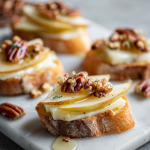
Pear & Brie Crostini
- Total Time: 17 mins
Description
Warm, buttery baguette, creamy Brie, sweet pear, golden honey, and crunchy pecans—these crostini are the perfect mix of flavors and textures. They look gourmet, taste divine, and come together in minutes. Whether for a holiday gathering, wine night, or just a little treat-yourself moment, these toasty bites bring effortless elegance to your table.
Ingredients
-
1 baguette, sliced into thin rounds (day-old works best)
-
4 oz Brie (or Camembert), sliced with rind on
-
1 ripe pear (Anjou or Bartlett), thinly sliced
-
2 tbsp honey (or maple syrup)
-
1/4 cup pecans, toasted and crushed
Instructions
-
Prep Bread – Preheat oven to 375°F (190°C). Arrange baguette slices on a lined baking sheet.
-
Layer – Top each slice with a Brie slice and 1–2 pear slices. Pat pears lightly with paper towel if juicy.
-
Bake – Bake 5–7 mins until bread is crisp and Brie is melty. Don’t overbake!
-
Finish – Drizzle warm crostini with honey and sprinkle with toasted pecans.
-
Serve Warm – Transfer to platter and enjoy immediately for peak oozy-cheese bliss.
Notes
Slice baguette on a diagonal for extra surface area and rustic charm. For variation, swap pears with figs or add a sliver of prosciutto for salty contrast.
- Prep Time: 10 mins
- Cook Time: 7 mins
Nutrition
- Calories: 120 cal Per Serving
- Fat: 6g
- Carbohydrates: 13g
Quick Nutritional Info (Per Crostini)
Approximately: ~120 calories | 6g fat | 13g carbs | 3g protein
Note: This is an estimate based on the specific ingredients listed. Values can vary depending on brands and exact quantities used.
Final Thoughts
And there we have it, friend. From the first whiff of toasting bread to the last crumb on the platter, we’ve journeyed through the simple, yet profound, magic of creating something beautiful and delicious. This Pear & Brie Crostini recipe is so much more than a list of ingredients and steps; it’s a story. It’s a story of my nervous Friendsgiving triumph that became a signature dish. It’s a lesson in balancing textures and flavors to create a perfect bite. It’s an invitation to see a simple appetizer as a versatile player in any meal. And it’s a deep dive into the rich world of cheese, encouraging curiosity and exploration.
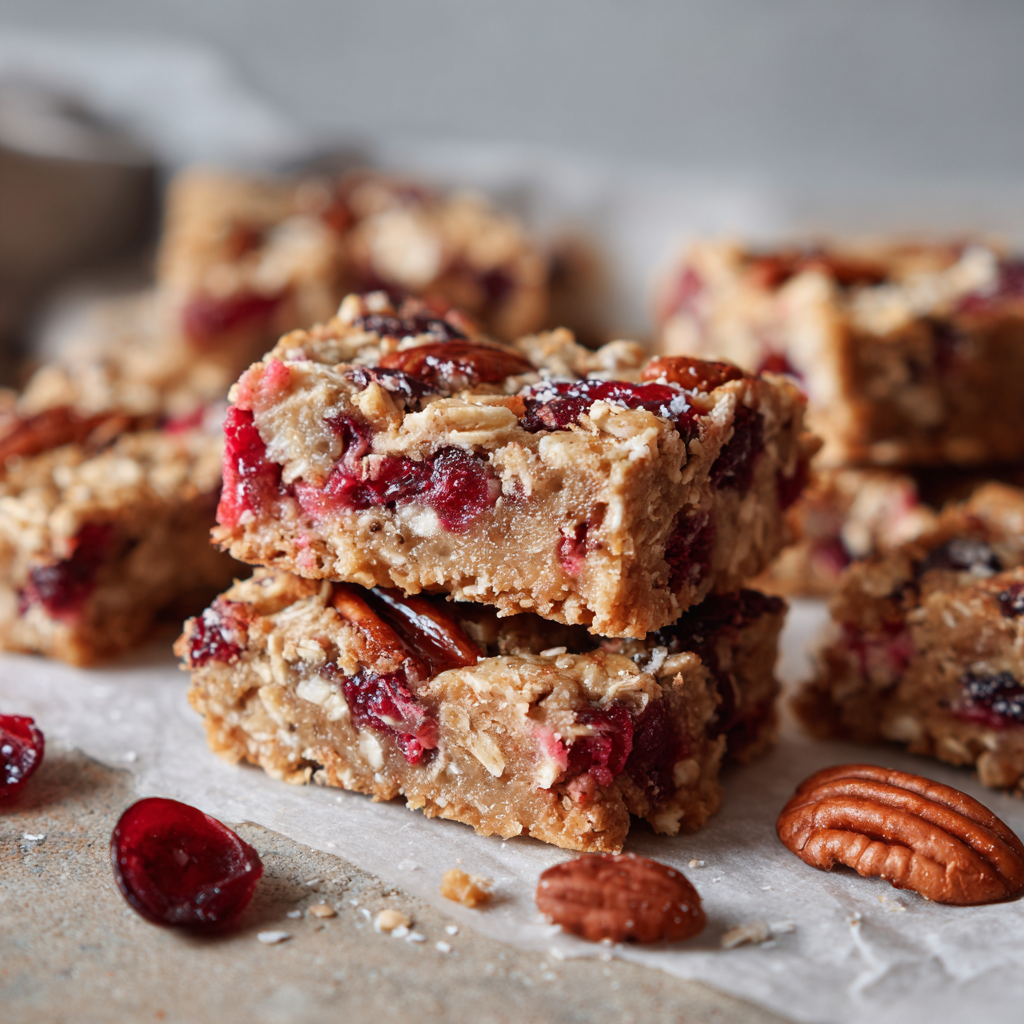
Maple Cranberry Oat Bars
Hey There, Fellow Flavor Explorer!
Is there anything better than that warm, inviting aroma of something sweet and wholesome baking in the oven? You know the one – it wraps around you like a cozy hug, promising deliciousness is moments away. If your heart does a little happy dance at the thought of a simple, satisfying treat that tastes like pure comfort and *actually* fuels your day, you and I are kindred spirits! Welcome back to my kitchen – pull up a stool, grab a mug of something warm, and let’s bake up some pure joy.
Today, we’re diving headfirst into one of my absolute *go-to* creations: Maple Cranberry Oat Bars. These aren’t just any bars, my friend. Imagine chewy, nutty goodness held together with the rich depth of pure maple syrup, studded with bursts of tart cranberries and satisfyingly crunchy nuts. They’re wholesome enough to make you feel good (hello, oats and flax!), delicious enough to satisfy any sweet craving, and sturdy enough to toss in your bag for that mid-morning slump or afternoon adventure. No fussy techniques, no obscure ingredients – just pure, uncomplicated, homemade magic ready in about 30 minutes. Whether you’re fueling a busy weekday, prepping for a hike, or just need a little moment of sweetness with your coffee, these bars are your new best friend. Ready to bake some happiness? Let’s get mixing!
A Taste of Autumn Adventures
These Maple Cranberry Oat Bars? They totally have a backstory, and it involves a slightly chaotic, utterly wonderful family apple-picking trip a few years back. Picture this: crisp fall air, leaves crunching underfoot, baskets overflowing with way more apples than we could possibly eat. My niece, Maya, then about six, was buzzing with excitement (and sugar from a cider donut!). By mid-afternoon, the inevitable “I’m huuuungry!” chorus started. I hadn’t packed enough snacks (rookie move!).
Back home, tired but happy, I needed something quick, nourishing, and kid-approved before the apple-peeling marathon began. I scanned the pantry: oats, maple syrup from a local farm stand we’d passed, leftover cranberries from Thanksgiving prep, almonds… bingo! I threw this combo together on a whim, pressed it into a pan, and crossed my fingers. The smell alone brought everyone wandering back into the kitchen. When I cut those still-warm bars? Pure bliss. Maya declared them “way better than donuts” (high praise!), and my brother snagged three for the road. They became our official “Apple Orchard Recovery Bars.” Now, every time I make them, I smell fallen leaves and hear Maya’s giggle. That’s the power of a simple recipe – it captures a moment.
Gathering Your Flavor Crew
Here’s the beautiful, simple lineup! Most of these are pantry staples, and I’ve got your back with swaps if needed. Let’s meet the team:
- 1 1/2 cups rolled oats (old-fashioned oats): The hearty base! They give that perfect chew. Chef’s Tip: Don’t use quick oats here – they get too mushy. Gluten-free? Ensure your oats are certified GF!
- 1/4 cup ground flaxseed: My secret weapon for a nutritional boost (hello, fiber & omega-3s!) and helping bind everything. Swap: Chia seeds (ground or whole) work great too!
- 1/2 tsp cinnamon: Just enough warm spice to cozy things up. Insight: Try a pinch of nutmeg or cardamom with it for a fun twist!
- 1/4 tsp salt: Crucial! It balances the sweetness and makes all the flavors pop. Don’t skip it!
- 1/2 cup pure maple syrup: The star sweetener! Its deep, caramel notes are irreplaceable. Chef’s Plea: Use the *real* stuff – pancake syrup just won’t cut it. Swap (in a pinch): Honey or agave, but the flavor profile changes.
- 1/4 cup almond butter or peanut butter: Adds richness, healthy fats, and acts as the glue. Smooth is best here! Insight: I love almond butter’s mildness, but PB gives a stronger flavor punch. Sunflower seed butter works for nut-free!
- 1 tsp vanilla extract: The flavor enhancer! Pure vanilla makes everything taste more… well, everything! Bonus Tip: A splash of almond extract is lovely with the cranberries.
- 1/3 cup dried cranberries: Those gorgeous tart jewels! Chef’s Fave: Look for unsweetened or fruit-juice-sweetened ones if you can. Swap: Chopped dried cherries, apricots, or raisins.
- 1/3 cup chopped pecans or almonds: For that essential crunch and nutty depth. Insight: Toast them first for *maximum* flavor! Just 5-7 mins in a 350°F oven. Swap/Add: Walnuts, pepitas, sunflower seeds.
Let’s Bake Some Magic: Step-by-Step
See? I told you this was easy! Let’s walk through it together. Remember, cooking is about feeling, not just following – so trust your instincts!
- Preheat & Prep (175°C/350°F): “Preheat your oven to 350°F (175°C). Line an 8×8-inch baking pan with parchment paper, leaving some overhang on two sides.” Why? This little parchment “sling” is your BEST FRIEND. It makes lifting the whole slab of bars out for cutting SO much easier and cleaner than trying to dig them out. Seriously, don’t skip this step! Lightly greasing the pan under the paper helps it stay put.
- Mix Dry Ingredients: “In a large bowl, combine the rolled oats, ground flaxseed, cinnamon, and salt.” Chef’s Hack: Give this a good whisk! It evenly distributes the cinnamon and salt, preventing any clumpy surprises. The flax mixes in way better this way too.
- Bring in the Wet Team: “Stir in the maple syrup, almond butter (or peanut butter), and vanilla extract until everything is very well combined and no dry spots remain.” Insight: This might take a minute of sturdy stirring! If your nut butter is super thick or cold, warm it slightly (10 secs in the microwave) to make blending easier. You want a uniform, slightly sticky mixture.
- Fold in the Fun Stuff: “Gently fold in the dried cranberries and chopped pecans (or almonds).” Key Word: Gently! We don’t want to crush the cranberries or nuts. Use a spatula and a folding motion (like you’re turning the batter over itself) until they’re evenly distributed.
- Press & Promise: “Transfer the mixture to your prepared pan. Press it down VERY firmly and evenly with the back of a measuring cup or your hands.” This is CRITICAL! Press, press, press! Get into the corners. The firmer you pack it, the better the bars will hold together later. I sometimes lay a piece of parchment on top and press down hard with my hands for an even surface.
- Bake to Golden Perfection: “Bake for 20-22 minutes, until the edges are a beautiful golden brown and the center looks set.” Watch Closely: Ovens vary! At 20 mins, check. The center might still look a touch soft, but it firms up as it cools. Overbaking = dry bars. The golden edges are your visual cue.
- Patience is a Virtue (The Hardest Step!): “Let the bars cool completely in the pan on a wire rack before attempting to slice.” Chef’s Confession: I KNOW it’s tempting. I’ve messed up bars by cutting too soon! They need time to set up properly. Rushing = crumbles. Go do something else for at least an hour, maybe two. Seriously!
- Slice & Celebrate: “Once completely cool, use the parchment paper overhang to lift the entire slab out of the pan. Place it on a cutting board and slice into 8 bars (or 16 squares!).” Tip: A sharp knife dipped in hot water and wiped dry between cuts gives the cleanest edges. But hey, rustic is charming too!
How to Serve Up the Goodness
These Maple Cranberry Oat Bars are the ultimate grab-and-go champions! Slice them, stack them in an airtight container, and stash them in your pantry (up to 5 days) or freezer (up to 3 months – they thaw quickly!). For a simple, satisfying breakfast, pair one with a piece of fruit and your morning coffee or tea. They’re perfect tucked into lunchboxes or as a post-workout refuel. Feeling fancy? Warm a bar slightly (10 seconds in the microwave) and serve it with a dollop of Greek yogurt or a drizzle of extra maple syrup for a cozy dessert. Honestly? They’re pretty darn perfect just as they are, held in your hand, savored bite by delicious bite.
Make It Your Own: Delicious Twists
The beauty of this base recipe is how easily it adapts! Here are a few ways to play:
- Chocolate Craving: Fold in 1/4 cup dark chocolate chips (mini chips distribute best) with the cranberries and nuts. Because chocolate makes everything better.
- Tropical Escape: Swap cranberries for chopped dried mango or pineapple, use macadamia nuts instead of pecans/almonds, and add 2 tbsp shredded coconut to the dry ingredients.
- Nut-Free Bliss: Use sunflower seed butter instead of almond/peanut butter, and swap the nuts for pepitas (pumpkin seeds) or sunflower seeds. Ensure oats are certified GF if needed.
- Apple Spice: Add 1/4 cup finely chopped dried apples and 1/4 tsp extra cinnamon or apple pie spice to the dry ingredients.
- Seedy Powerhouse: Replace 1/4 cup of the oats with a mix of sesame seeds, chia seeds, and hemp hearts for an extra nutrient boost.
Olivia’s Kitchen Chatter
These bars have truly evolved from that frantic post-orchard experiment! The first batch? Let’s just say they were more like “Maple Cranberry Oat Crumble” – delicious, but you needed a spoon! I quickly learned the vital importance of the PACK IT DOWN step and the agony of waiting for them to cool. I’ve probably made these a hundred times since, tweaking the ratio of syrup to nut butter, toasting the nuts religiously (game-changer!), and experimenting with every dried fruit and nut combo imaginable. One memorable (slightly disastrous) batch involved adding fresh orange zest… but forgetting it was still on the counter. My cat, Mr. Whiskers, found it first and had a *very* fragrant afternoon! Lesson learned: zest goes *in* the bowl! These bars are forgiving, though. Even my crumblier versions got devoured. They’re my little edible hugs, a reminder that simple, wholesome food, made with a dash of love (and maybe a messy apron), is often the most satisfying.
Your Questions, Answered!
Let’s tackle some common kitchen queries:
- Q: My bars fell apart! What did I do wrong?A: The two main culprits are usually: 1) Not pressing firmly enough into the pan. Really muscle it down! 2) Cutting too soon. They NEED that full cooling time to set. If they’re still crumbly after that, try adding 1 extra tablespoon of nut butter or maple syrup next time. Also, ensure your flax is ground!
- Q: Can I use honey instead of maple syrup?A: You can! Honey works as a 1:1 swap. The flavor will be different (more floral, less deep caramel), and honey tends to make bars a bit stickier. Agave nectar is another option. Just avoid artificial syrups.
- Q: How do I store these, and how long do they last?A: Store cooled bars in an airtight container at room temperature for 4-5 days. They also freeze beautifully! Wrap individual bars tightly in plastic wrap, then place in a freezer bag or container for up to 3 months. Thaw at room temperature for 30-60 mins or pop in the microwave for 10-15 seconds.
- Q: Can I make these vegan?A: Absolutely! They already are, as long as you use pure maple syrup (not honey) and a plant-based nut/seed butter. Double-check your dried fruit doesn’t contain hidden dairy or honey (some cranberries might).
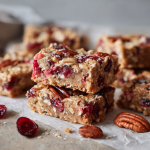
Maple Cranberry Oat Bars
- Total Time: 1 hr 30 mins
Description
Cozy, chewy, and packed with autumn flavor—these bars are your new snack-time soulmate. They’re made with simple pantry staples like oats, maple syrup, nut butter, and tart cranberries, then baked into golden perfection. The result? A nourishing treat that’s just as happy fueling your morning coffee ritual as it is tucked in a lunchbox or powering you through an afternoon slump. Quick, easy, and oh-so satisfying—this is homemade joy in bar form.
Ingredients
-
1 1/2 cups rolled oats (certified GF if needed)
-
1/4 cup ground flaxseed
-
1/2 tsp cinnamon
-
1/4 tsp salt
-
1/2 cup pure maple syrup
-
1/4 cup almond butter (or peanut butter/sunflower seed butter)
-
1 tsp vanilla extract
-
1/3 cup dried cranberries (unsweetened if possible)
-
1/3 cup chopped pecans or almonds (toasted for best flavor)
Instructions
-
Prep Pan – Preheat oven to 350°F (175°C). Line an 8×8″ pan with parchment (leave overhang).
-
Mix Dry – Combine oats, flaxseed, cinnamon, and salt in a bowl.
-
Add Wet – Stir in maple syrup, nut butter, and vanilla until fully combined.
-
Fold In Goodies – Mix in cranberries and nuts gently.
-
Press Firmly – Transfer mixture to pan, pressing down hard and evenly (this ensures bars hold together).
-
Bake – Bake 20–22 minutes until edges are golden.
-
Cool Completely – Let cool in pan before lifting out and slicing. Patience = perfect bars!
Notes
Pressing the mixture firmly into the pan is the secret to bars that hold together beautifully. For extra indulgence, add a sprinkle of dark chocolate chips before baking.
- Prep Time: 10 mins
- Cook Time: 20 mins
Nutrition
- Calories: 210 cal Per bar
- Fat: 9g
- Carbohydrates: 28g
- Fiber: 3g
- Protein: 5g
Nutritional Info (Per Bar)
~210 calories | 9g fat | 28g carbs | 5g protein | 3g fiber | 15g sugars (mostly natural from maple & fruit)
Note: This is an estimate. Actual values can vary based on specific ingredients used.
Final Thoughts
What began as a desperate attempt to feed a hungry family after a day of apple picking has truly become one of the most beloved recipes in my arsenal. These Maple Cranberry Oat Bars are the perfect example of how the most reliable, satisfying creations are often born from necessity and simplicity. They aren’t fussy or pretentious; they are honest, wholesome, and deeply comforting. They represent a philosophy I try to bring into my kitchen every day: that food should make you feel good, both in the making and in the eating.
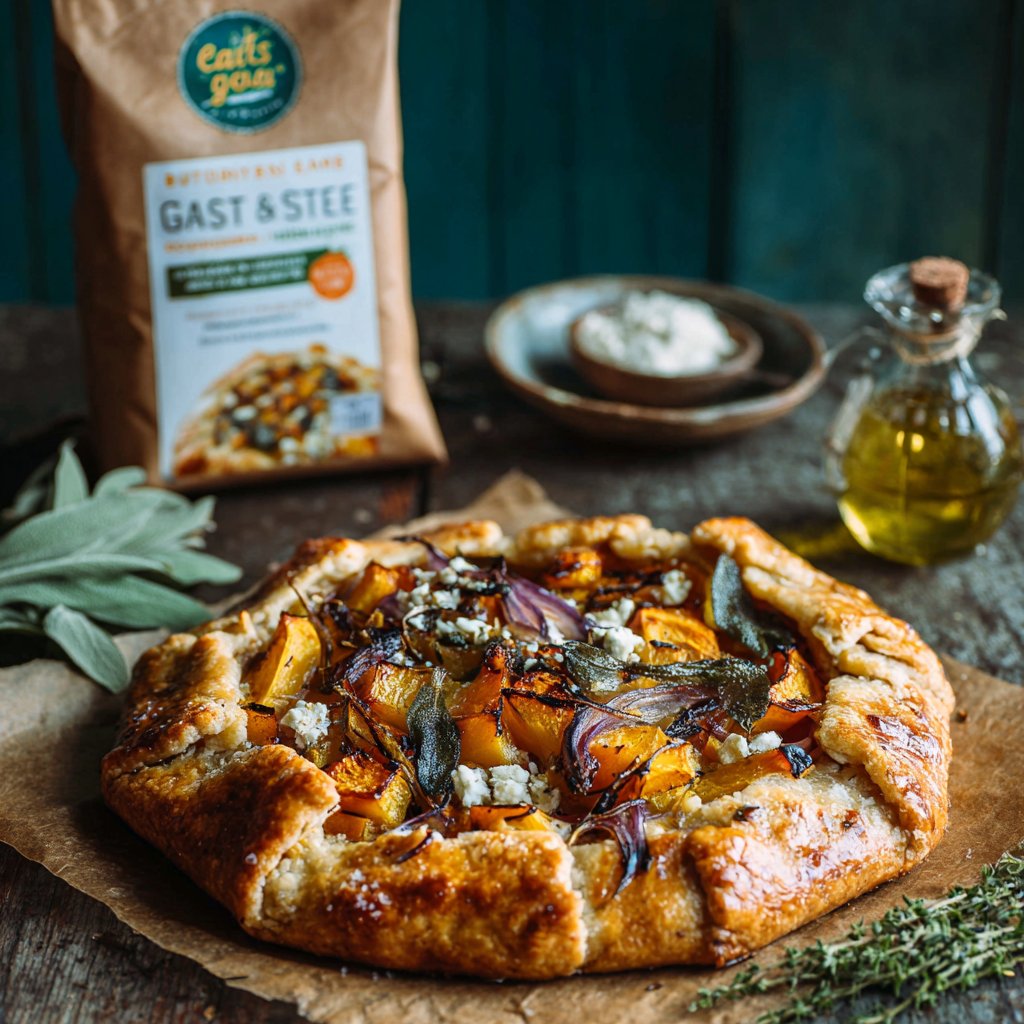
Butternut Squash & Sage Galette
Your New Favorite Fall Masterpiece: Butternut Squash & Sage Galette
Hey there, kitchen friend! Olivia here, waving from my flour-dusted countertop. Can we just take a moment to appreciate how magical autumn is for us food lovers? That crisp air, those golden leaves, and oh – that heavenly scent of roasting squash wafting from the oven. Pure cozy magic, right? Today, I’m practically bubbling over to share my absolute favorite fall showstopper: this Rustic Butternut Squash & Sage Galette. Imagine this: sweet, caramelized butternut squash and onions, fragrant fresh sage, and creamy goat cheese, all snuggled up in the flakiest, most buttery crust you’ve ever made. It bakes up golden and gorgeous, with those beautifully imperfect folded edges that whisper, “I’m homemade with love!” The best part? Galettes are wonderfully forgiving – no fancy tart pans or pastry perfection required. Whether you’re hosting a Friendsgiving, needing a stunning Meatless Monday centerpiece, or just craving some serious autumnal comfort, this beauty is your answer. Grab your apron (the messy one is totally welcome here), and let’s make some edible sunshine together!
A Slice of Autumn Memory
This galette always takes me back to my first tiny apartment kitchen – seriously, it was barely bigger than my cutting board! I was hosting my then-boyfriend (now husband) for our first “grown-up” autumn dinner date. Determined to impress, I tried a complicated layered tart. Spoiler: it collapsed spectacularly. In a panic, I scraped the filling onto some rolled-out pastry dough, frantically folded the edges over, and prayed. What emerged from the oven was pure serendipity: a golden, rustic galette that looked straight out of a French countryside dream. His eyes lit up, and that first bite? Silence, followed by the happiest “Mmm!” I’d ever heard. That messy, accidental galette became our tradition. Every fall since, when the air turns crisp and the squash piles high at the market, I make this. It’s not just dinner; it’s a warm hug of a memory, a reminder that sometimes the most beautiful things come from happy little kitchen “oops” moments. And trust me, that’s the spirit we’re channeling today!
Gathering Your Galette Goodness
Let’s gather our cozy flavor squad! Don’t stress about exact perfection – cooking is an adventure.
For the Flaky, Dreamy Crust:
- 1 1/4 cups all-purpose flour: Our trusty base! For a nuttier twist, swap in 1/2 cup whole wheat pastry flour. (Chef Insight: Spoon & level it for accuracy, don’t scoop!)
- 1/2 tsp salt: Balances the sweetness and enhances every flavor. Essential!
- 1/2 cup (1 stick) COLD unsalted butter, cubed: Key to flakiness! Keep it fridge-cold until the second you use it. Vegan? A high-quality plant-based butter works surprisingly well here.
- 3–4 tbsp ICE WATER: Literally ice-cold. It keeps the butter from melting, creating those coveted flaky layers. Add just enough to bring the dough together.
For the Soul-Warming Filling:
- 1 1/2 cups butternut squash, thinly sliced & roasted: Look for a small, dense squash for best flavor and texture. (Chef Hack: Use pre-cubed squash to save time, just slice it thin!)
- 1 medium onion, caramelized: Yellow or sweet onions work wonders. Low and slow is the caramelization mantra! Patience = sweet gold.
- 1 tbsp fresh sage, finely chopped: Autumn in an herb! Dried sage can pinch-hit (use 1 tsp), but fresh is truly magical here.
- 1/4 cup crumbled goat cheese OR grated Parmesan: Goat cheese adds tangy creaminess, Parmesan offers salty depth. Both are winners! Vegan? Try crumbled firm tofu mixed with nutritional yeast or a plant-based feta.
- Salt and freshly ground black pepper to taste: Season at every layer! Taste your roasted squash and onions before assembling.
The Finishing Touch:
- 1 egg, beaten (for egg wash): Gives that gorgeous golden sheen. Vegan? Brush with plant milk or olive oil.
Let’s Build Your Golden Masterpiece!
Ready for the fun part? Let’s roll up our sleeves (literally!). This is where the magic happens.
- Make the Dough (It’s Easier Than You Think!): Whisk the flour and salt together in a large bowl. Toss in those cold butter cubes. Now, using a pastry cutter, two forks, or even your fingertips (work quickly so the butter stays cold!), cut the butter into the flour until you have a mix of pea-sized pieces and sandy crumbs. Chef Tip: Don’t overwork it! Those butter chunks = future flaky layers. Drizzle in the ice water, 1 tablespoon at a time, gently mixing with a fork after each addition. Stop when the dough just starts to clump together when pressed. Dump it onto a lightly floured surface, gather it gently into a disk (don’t knead!), wrap tightly in plastic, and chill for at least 30 minutes. Why Chill? This relaxes the gluten and firms up the butter again – crucial for a tender, flaky crust that won’t shrink!
- Roast the Squash to Sweet Perfection: While the dough chills, preheat your oven to 400°F (200°C). Toss your thinly sliced butternut squash with a drizzle of olive oil, salt, and pepper on a baking sheet. Spread it out in a single layer – overcrowding steams instead of roasts! Roast for about 20 minutes, or until tender and slightly caramelized at the edges. Let it cool slightly. Chef Hack: Thin slices = quicker roasting and easier stacking!
- Work Your Onion Magic (Caramelize!): Heat a glug of olive oil or a pat of butter in a skillet over medium-low heat. Add your thinly sliced onion. Sprinkle with a tiny pinch of salt (this helps draw out moisture). Cook low and slow, stirring occasionally, for 15-20 minutes. Resist cranking the heat! Let them turn deeply golden, sweet, and jammy. Chef Insight: This is flavor foundation! Don’t rush it.
- Assemble Your Galette (& Embrace the Rustic!): Preheat your oven now to 375°F (190°C). Roll out your chilled dough on a lightly floured surface (or directly on parchment paper for easy transfer!) into a rough circle, about 10-12 inches across and 1/8-inch thick. Don’t sweat perfection! Transfer the dough (on parchment if using) to a baking sheet. Spread the caramelized onions evenly over the center, leaving a 2-inch border clear all around. Artfully arrange the roasted butternut squash slices over the onions. Sprinkle the chopped fresh sage and your chosen cheese (goat cheese or Parmesan) over the top. Season generously with salt and pepper. Chef Tip: Layer slightly overlapping squash slices for beautiful texture.
- Fold, Brush, Bake to Golden Glory: Now, the fun fold! Gently lift the bare edges of the dough and fold them up and over the filling, pleating as you go to create that gorgeous, rustic border. It’s okay if it cracks a little – character! Brush the folded crust generously with the beaten egg wash. This gives that irresistible shine and golden color. Pop it into the preheated oven and bake for 35-40 minutes. You’ll know it’s done when the crust is a deep, rich golden brown and the filling is bubbling enticingly at the edges.
Serving Your Savory Stunner
Let that gorgeous galette rest for 5-10 minutes after baking – it makes slicing cleaner! Slide it onto a cutting board or rustic wooden platter for maximum charm. I love to garnish it with a few extra fresh sage leaves or a tiny drizzle of good quality honey or balsamic glaze for a sweet-tangy counterpoint. Slice it into wedges like a pie. This beauty is incredibly versatile: serve it warm as the star of a vegetarian meal alongside a simple arugula salad with lemon vinaigrette, or as an impressive side dish with roast chicken or pork. It shines at brunch, lunch, or dinner. Bonus? Leftovers (if you have any!) are amazing slightly warmed or even at room temperature. Pure autumn bliss on a plate!
Make It Your Own: Delicious Twists!
This galette is your culinary canvas! Try these fun spins:
- Sweet Potato Swap: Replace butternut with thinly sliced, roasted sweet potatoes for a deeper sweetness.
- Nutty Crunch: Sprinkle 1/4 cup toasted walnuts, pecans, or pumpkin seeds over the filling before adding the cheese.
- Apple & Cheddar Twist: Add 1 thinly sliced, sautéed apple (like Honeycrisp) with the onions and swap goat cheese for sharp cheddar.
- Rosemary Rendezvous: Swap sage for fresh rosemary (use a bit less, it’s potent!) for a woodsy note.
- Vegan Delight: Use vegan butter in the crust, skip the egg wash (use plant milk), and top with vegan feta or a sprinkle of nutritional yeast.
Olivia’s Cozy Kitchen Notes
This galette has truly evolved with me! That first panicked version only had onions and squash – the sage and cheese were happy later additions after a trip to a farmer’s market. I used to stress over rolling the “perfect” circle, but honestly? The more rustic and free-form it looks, the more charm it has! One hilarious disaster involved me forgetting the parchment paper… let’s just say the galette became permanently fused to the baking sheet. We ate the salvageable top part with spoons – still delicious, still a story! Over time, I learned the power of really cold ingredients for the crust and the patience for truly caramelized onions. Don’t be afraid to play – that’s how the best kitchen memories (and recipes!) are made. This galette feels like sharing a piece of my cozy kitchen heart with you.
Galette Questions? We’ve Got Answers!
Let’s tackle some common hiccups to make sure your galette is flawless:
- Q: Can I make any parts ahead?
A: Absolutely! The dough disk can chill for up to 2 days. Roast the squash and caramelize the onions 1-2 days ahead; store them separately in the fridge. Assemble the galette cold, straight from the fridge – just add a few extra minutes to the bake time. - Q: Help! My crust is soggy on the bottom.
A: A few tricks: 1) Ensure your roasted squash isn’t watery – roast until tender but not mushy. 2) Roll your crust thin enough (1/8-inch). 3) Bake on a preheated baking sheet or pizza stone if you have one. 4) If super paranoid, you can pre-bake the crust (with parchment & pie weights) for 10 mins at 375°F before adding filling. - Q: My dough is cracking when I try to fold it. What do I do?
A: No panic! This often means the dough is a tad dry or too cold. Let it sit at room temp for 5-10 minutes. If it cracks while folding, just gently press it back together – the egg wash will help seal it. Imperfections are rustic charm! - Q: Can I freeze this galette?
A: Yes! Freeze the unbaked, assembled galette solid on the baking sheet, then wrap tightly in plastic and foil. Bake straight from frozen, adding 10-15 minutes to the bake time. You can freeze leftovers too, though the crust is best fresh.
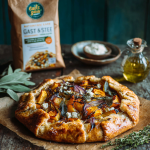
Butternut Squash & Sage Galette
- Total Time: 1 hr 35 mins
Description
Golden leaves, cool air, and the scent of roasting squash—this galette is pure autumn comfort. Flaky, buttery pastry cradles sweet butternut squash, caramelized onions, earthy sage, and creamy goat cheese. Rustic in look, rich in flavor, and forgiving in technique—it’s as perfect for Friendsgiving as it is for a cozy weeknight dinner. Grab your rolling pin (perfection not required!) and let’s bake this warm hug of a dish.
Ingredients
For the Crust
-
1 1/4 cups all-purpose flour
-
1/2 tsp salt
-
1/2 cup cold unsalted butter, cubed
-
3–4 tbsp ice water
For the Filling
-
1 1/2 cups butternut squash, thinly sliced & roasted
-
1 medium onion, caramelized
-
1 tbsp fresh sage, chopped (or 1 tsp dried)
-
1/4 cup goat cheese (or Parmesan)
-
Salt & black pepper to taste
Finishing Touch
-
1 beaten egg (or plant milk for vegan glaze)
Instructions
-
Make Dough – Mix flour + salt. Cut in cold butter until pea-sized crumbs. Add ice water gradually until dough holds together. Shape into a disk, wrap, and chill 30 mins.
-
Roast Squash – Preheat oven to 400°F (200°C). Toss squash slices with oil, salt, pepper. Roast 20 mins until golden and tender.
-
Caramelize Onion – Cook onion slowly in oil/butter over medium-low heat for 15–20 mins until soft and golden.
-
Assemble Galette – Roll chilled dough into a 10–12″ rustic circle. Spread onions in center, layer roasted squash, sprinkle sage + cheese. Leave 2″ border.
-
Fold & Bake – Fold edges over filling. Brush crust with egg wash. Bake at 375°F (190°C) for 35–40 mins until crust is golden brown.
-
Serve & Enjoy – Rest 5 mins before slicing. Garnish with extra sage, honey, or balsamic glaze if desired.
Notes
For extra crisp crust, bake galette on a preheated baking sheet or pizza stone.
- Prep Time: 25 mins
- Cook Time: 40 mins
Nutrition
- Calories: 300 cal Per Serving
- Fat: 18g
- Carbohydrates: 28g
Nourishment Note (Approximate per serving):
Serves: 4 | ~300 calories | 18g fat | 28g carbs | 7g protein
(Remember, exact values depend on specific ingredients/portions used!)
Final Thoughts: More Than a Recipe
In a world of overly complicated recipes and the relentless pursuit of culinary perfection, this Butternut Squash & Sage Galette stands as a beautiful reminder of what truly matters in cooking: heart, flavor, and the joy of sharing. It’s a recipe that began not with expertise, but with a happy accident—a moment of kitchen panic that turned into a cherished memory. That spirit is woven into its very DNA. It’s designed not to intimidate, but to empower. It asks for your patience with the onions and your cold butter for the crust, but it rewards you with a depth of flavor and a texture that feels both humble and luxurious.
This galette is more than a list of ingredients and instructions; it’s an invitation. An invitation to slow down, to appreciate the process of caramelizing onions and roasting squash. An invitation to get your hands dusty with flour and to not fear a cracked or imperfect edge. It’s an invitation to play, to swap in sweet potatoes or apples, to add a crunch of nuts, or to make it your own. This recipe is a template for creativity and a vessel for making new memories. It’s the centerpiece of a quiet weeknight dinner that feels special, the star of a holiday table that sparks conversation, and the edible, warm hug we all need as the days grow shorter and colder.

